Best Bike Lights 2025: reviewed by cyclists for night riding & dark commutes
The Cycling Weekly team of experts tested dozens of lights, from budget beams to high-power smart systems, to guarantee your visibility and safety this winter, whatever your budget

Hannah Bussey
Now includes our 2025 fall/winter testing, where we crowned a new best overall front light, and keeping with 2025's trend, now features more smart lights.
It's that time again, when those of us in the northern hemisphere need to rummage in the drawer, find some of the best bike lights, get them charged, and fasten them to the bike ahead of night rides and dark commutes.
Every year, the Cycling Weekly tech team tests dozens of the best lights for night riding. This year, we sent Tech Editor Andy Carr out onto a dark farm track in the wind and rain to put more than 30 of the latest lights through their paces. Andy evaluated these lights for much more than just their brightness. His primary considerations included build quality, battery life, and, by far, the most important factor: how the light beam is projected onto the road or trail.
In this guide, I’ve compiled a selection of our best-rated bike lights that the Cycling Weekly team has reviewed over the last year. One standout is our new 2025 best overall front light, the fantastic Ravemen K1400, a near-perfect bike light.
Whether you are hitting the back lanes and gravel tracks this autumn/fall and winter on one of the best gravel bikes or cruising through the dimly lit streets of the city on one of the best commuter bikes, I have tried to cover all the bases.
2025 marks a significant advancement for bike lights, as nearly every brand introduces some form of adaptive feature or connectivity across its range, making them smarter and enhancing safety. With several lights already on the market and tested by our team, you should consider our best overall rear light, the Magicshine SEEMEE 300.
For simplified browsing, I have categorised the lights into the best front lights, rear lights, top light sets and best smart lights.
The Quick List
Front Lights
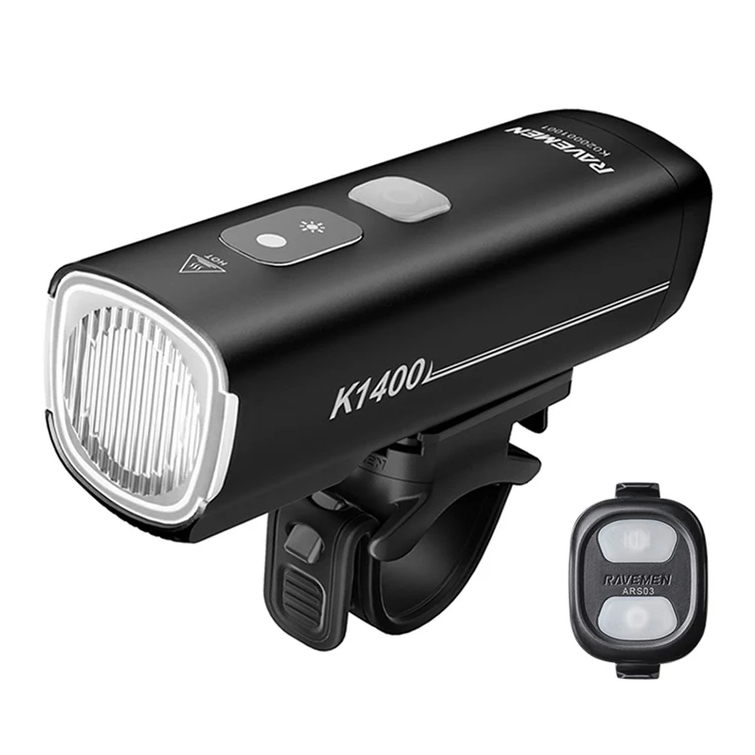
For its modest 1400 lumens, it was one of the brightest in this year's testing. Given its feature-rich performance and budget price, it is hard to beat, which is why it is our best overall for 2025.

If you’ve never heard of Magicshine, where have you been? With customisable modes, a remote, and a replaceable battery, the Allty 1500s misses out on the top spot purely for being ever so slightly more expensive than the K1400.

The Cateye AMPP 2200 real is the complete package, combining fantastic build quality, a rock-solid mount, tons of power, a great beam, and all at a pretty reasonable price.
See 3 more front lights

Surprisingly bright considering its compact size, the Kong Blinder 900 is only outshone by the Exposure Strada, and rightly so, as the Strada is three times the cost.
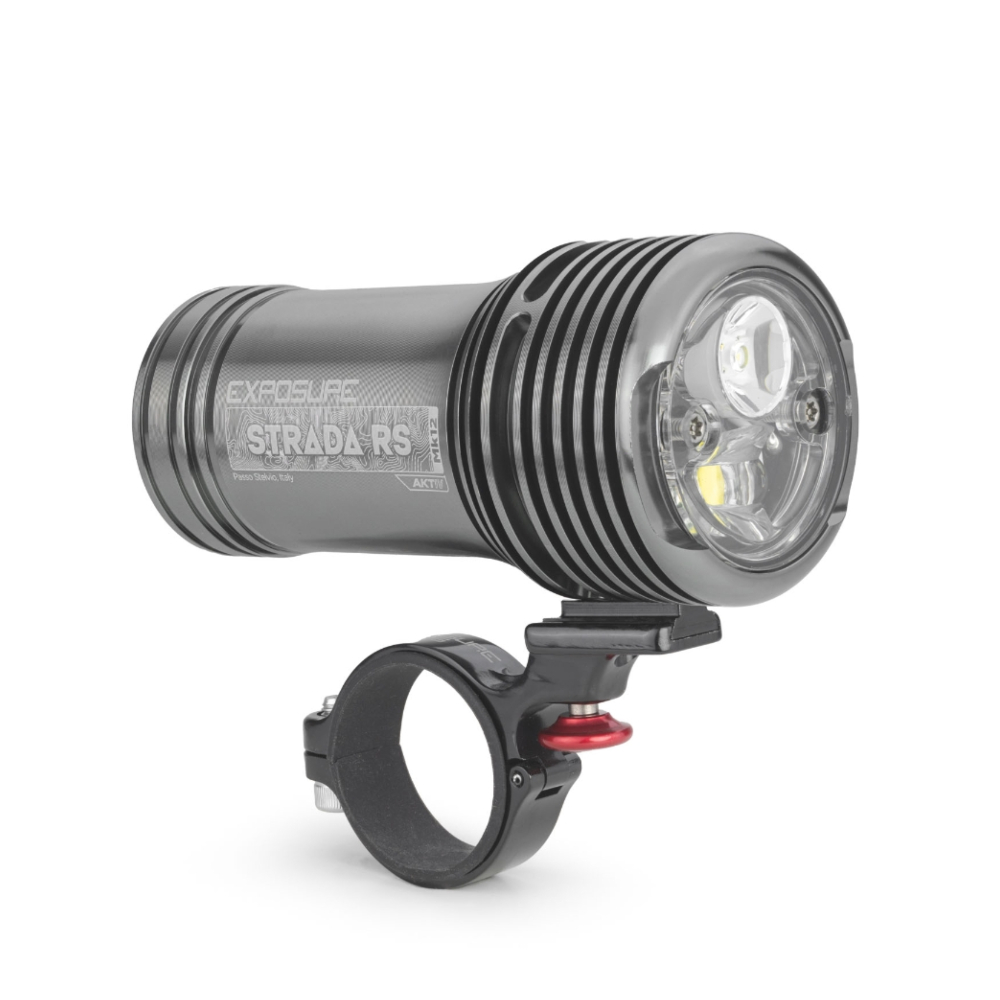
Exposure has a strong reputation for the build quality of its lights, and the Strada is no different. It has an immense beam, and the lens provides great side illumination.

The Micro Drive 800+ is versatile and ideal for a wide range of applications. Its low weight and flexibility make it a strong choice for those seeking a compact light with decent power.
Rear Lights

Feature-packed and boasting incredible battery life - while being competitively priced, the Magicshine SEEMEE300 is our overall winner and for good reason.
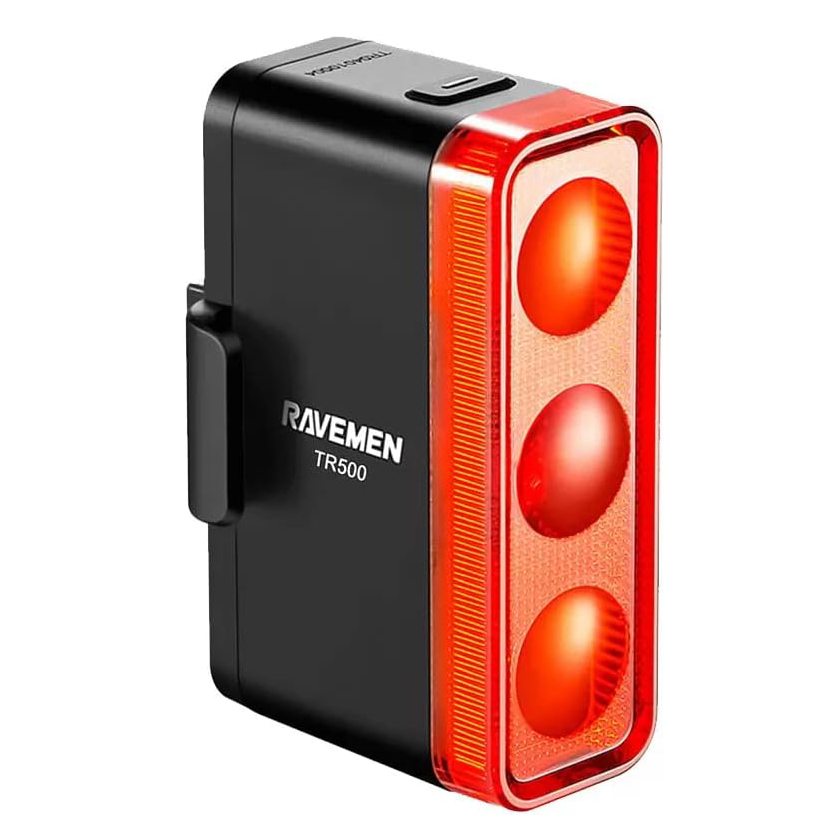
The Ravemen TR500 is a pretty close contender for being rear-light on test, only let down by its battery life. That doesn't take away from it being the best daytime running light.

The Topeak Taillux doesn’t pack fancy features, but it does have a 100-lumen flash mode, respectable battery life, and is an all-around solid performer at a very reasonable price.
See 3 more rear lights
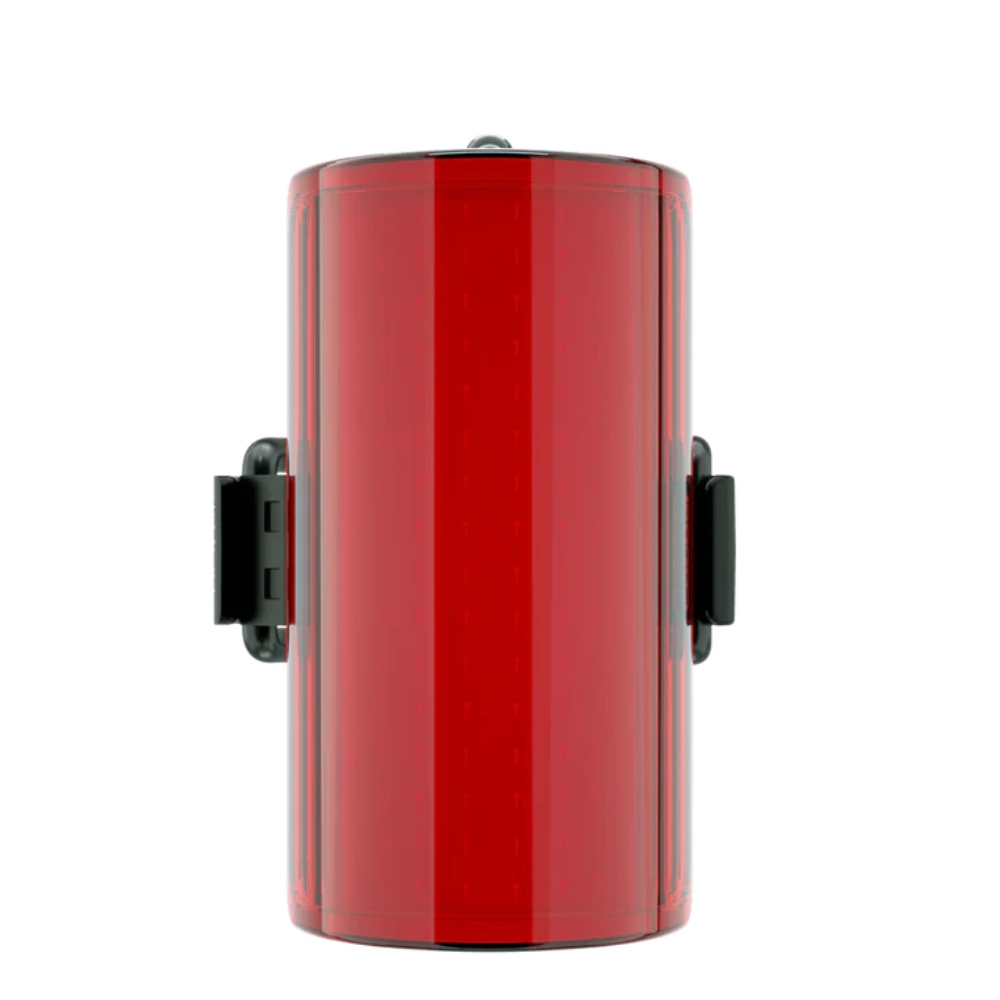
The Knog Mid Cobbers 330-degree visibility gives exceptional viewing angles, and when combined with a super bright 170-lumen flash, you are sure to be seen.
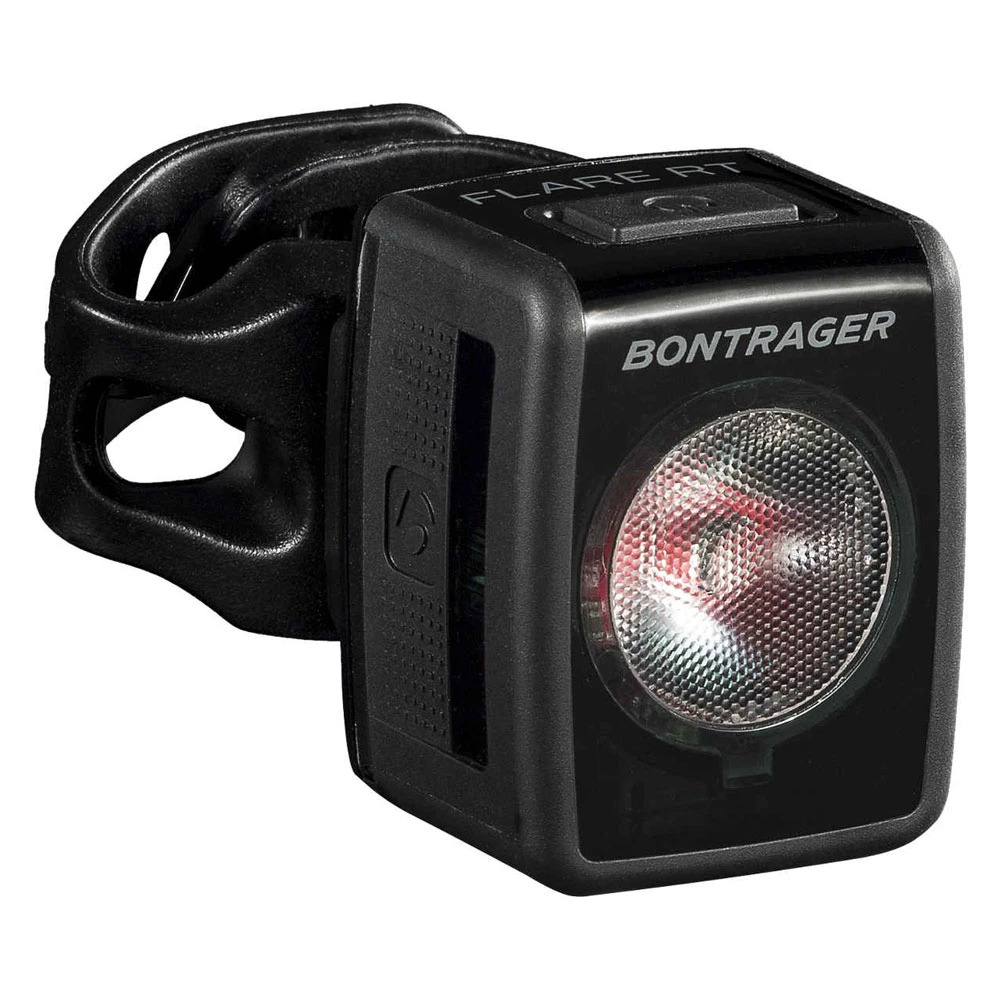
The Flare RT is best suited to someone who really cares about size and weight, which limits its battery life. Otherwise, it's perfectly serviceable for both daytime and nighttime use.

The CatEye ViZ300 is dazzlingly bright and has the battery life to outshine many of its competitors when combined with excellent viewing angles.
Light sets

The small but mighty Giant Recon HL 100 & TL 100 combo really punches above its weight. For lights that are so small, they are surprisingly bright, to the point of being blinding.
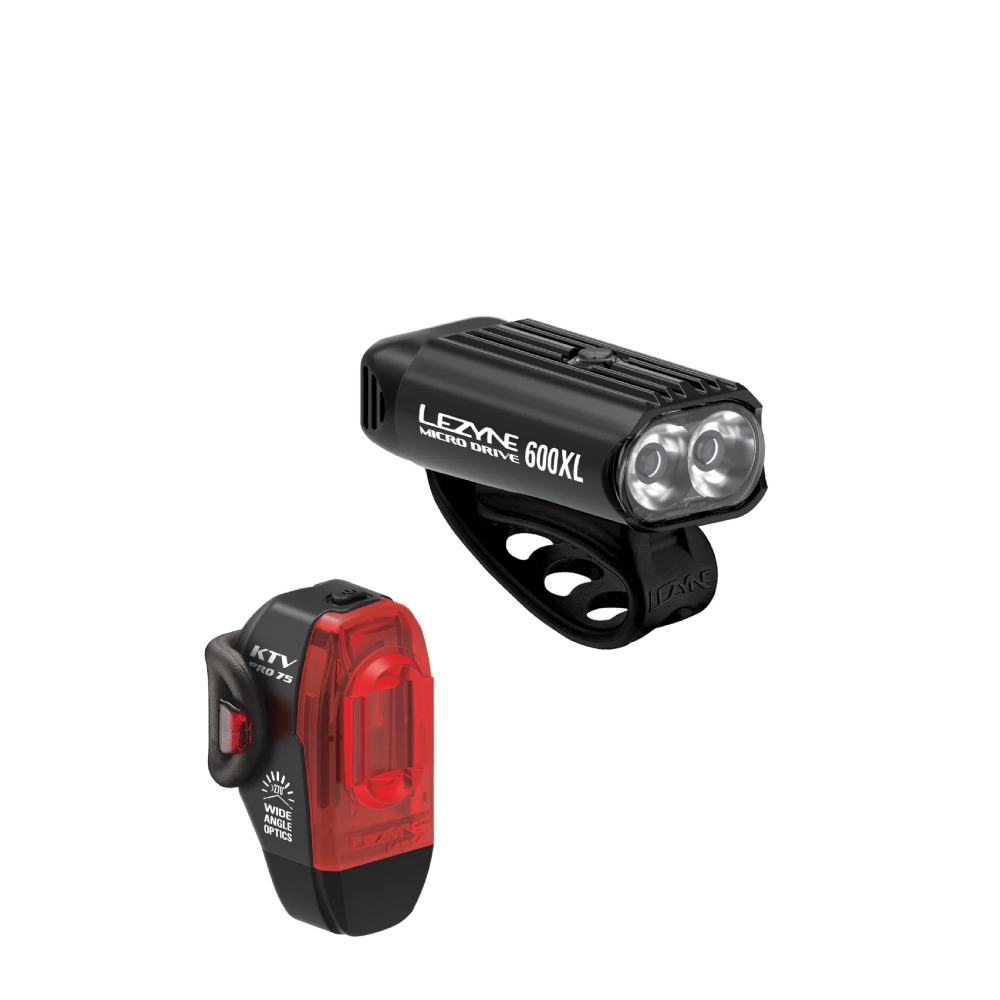
The Micro Drive 600XL and KTV Pro are rare in the market, with most manufacturers choosing not to offer light sets at higher power outputs.
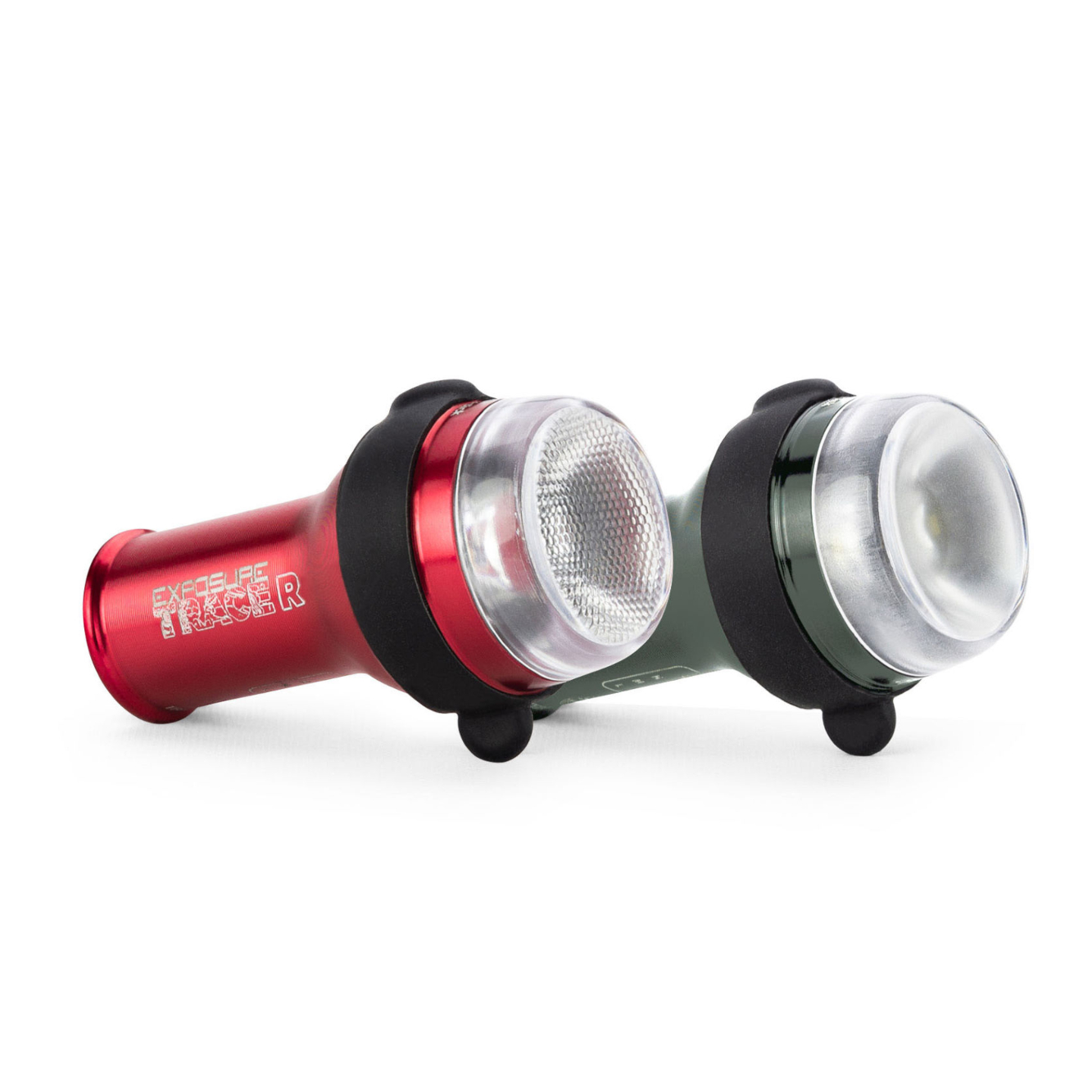
Tiny, robust, extremely bright, and with long burn times, there is little to fault with the Exposure Trace and TraceR light set other than the rear seatpost mount.
Radar/Smart Lights
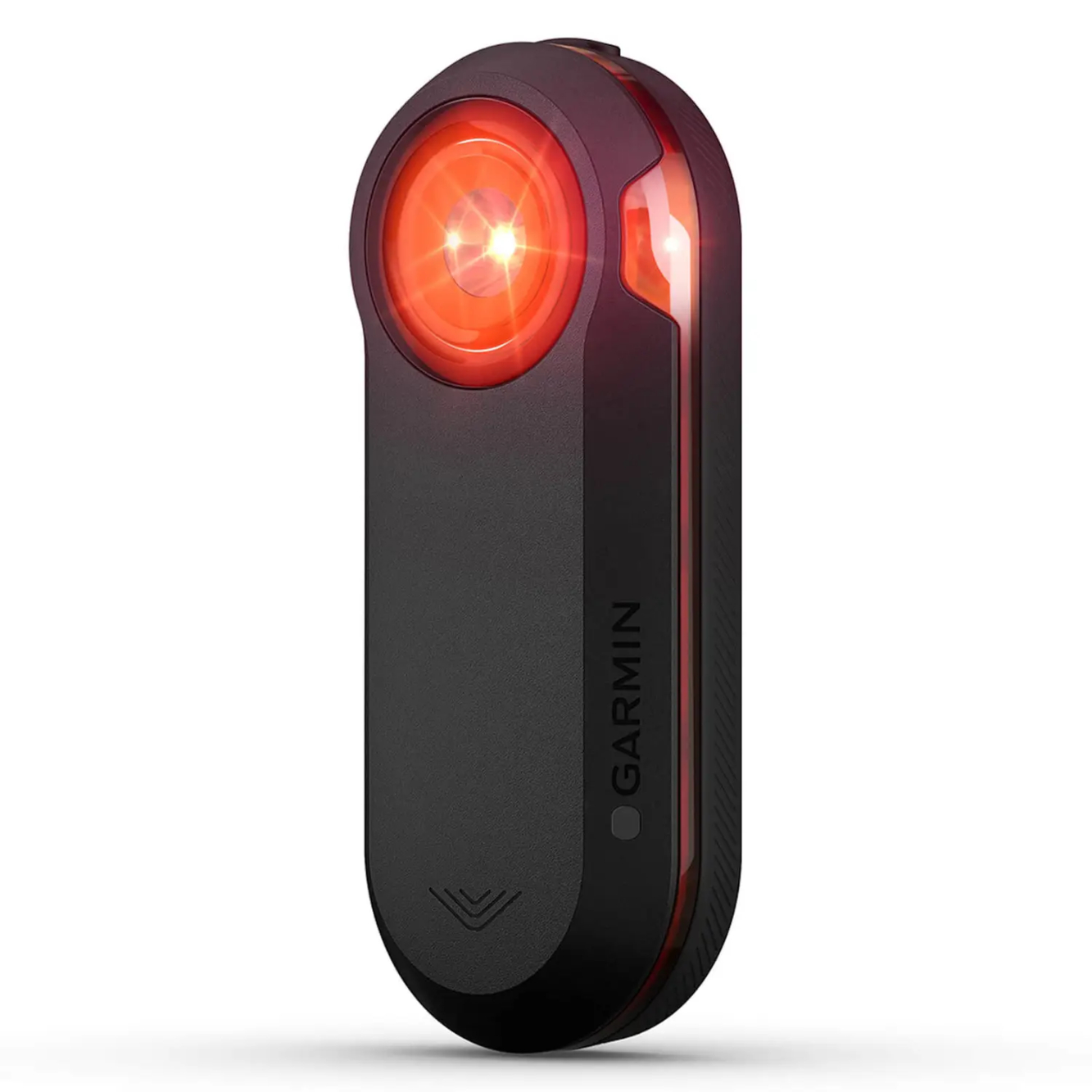
Possibly the future of all bicycle lights, the Garmin Varia RTL515 not only adjusts the light's mode but actually tells you where cars are on the road.
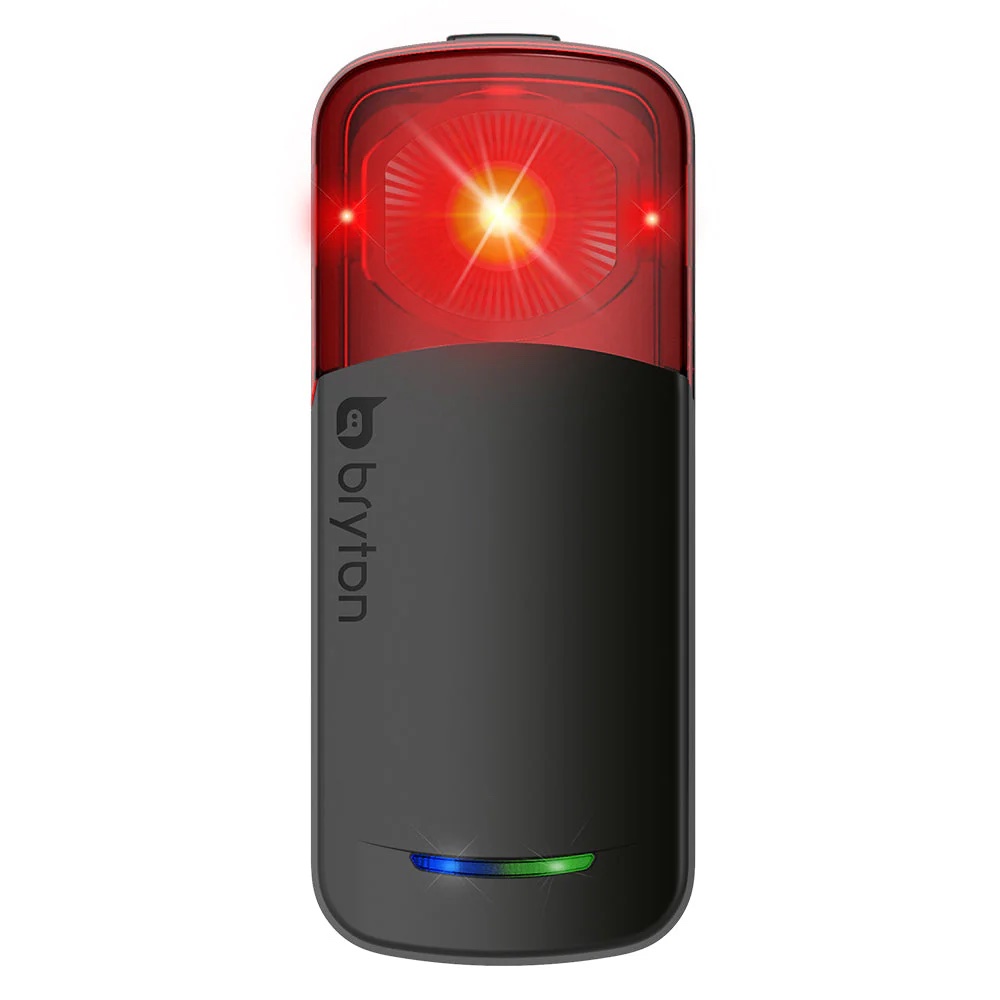
The Bryton Gardia R300L is a solid effort but just misses out on beating its main rival, the Garmin Varia. That said, it is considerably more affordable.

The Trackr Radar is certainly more feature-rich than its main competitor, the Varia, and costs about the same. The Garmin does have a wider field of view; however, in every other area, its performance is exemplary, and I highly recommend it.
Best front bike lights
Best front bike light overall
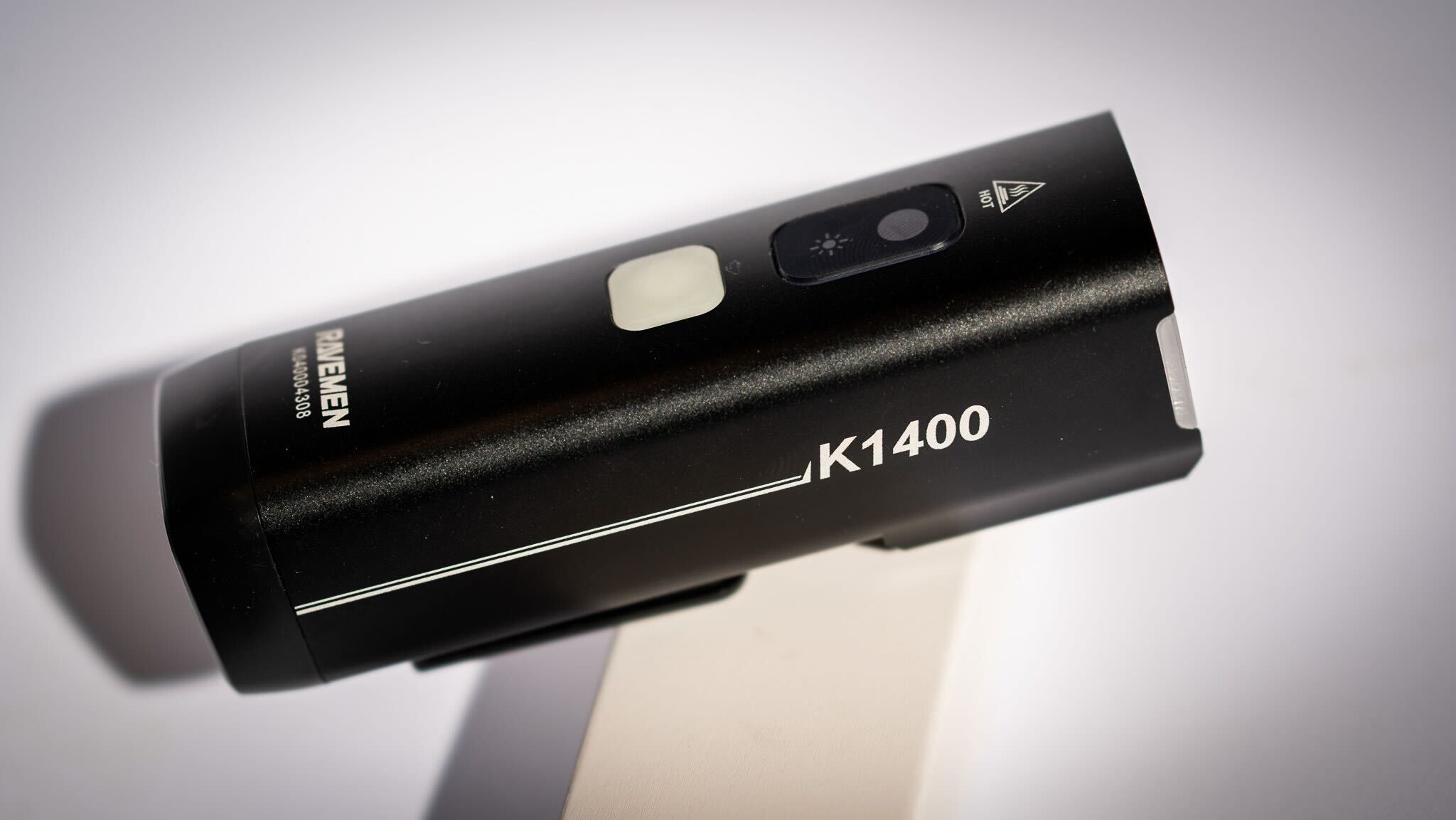
1. Ravemen K1400
Our expert review:
Specifications
Reasons to buy
Reasons to avoid
The Raveman K1400 is thoughtfully designed with a variety of features that enhance your riding experience. It has a light sensor that automatically adjusts the output based on riding conditions, helping to conserve or optimise battery life. The 4000mAh battery is impressive, with Raveman claiming it can last up to 23 hours on a full charge. During my tests on a centrally heated room, where I checked drain times on each unit, the K1400 lasted slightly longer than the quoted 1.5 hours at maximum output.
The well-finished machined casing, despite having a few sharp edges, fits nicely with the plastic components of the lens and other parts. Weighing about 177 g, it feels reasonably lightweight.
The button provides a satisfying click, and you don't need to press hard to cycle through modes, which follow a logical sequence. While it can get warm, a heatsink underneath helps dissipate some heat, with a warning symbol to keep you aware.
It's rated IPX7 for water resistance, meaning it's designed to be fully protected in heavy rain. This rating also indicates it can withstand immersion in up to 1 metre of water for half an hour. The rubber flap is a bit fragile and might not last forever, so a little gentle handling is advised.
For a modest 1400 lumens, it's one of the brightest in our test, and it offers great value, by being even cheaper than Magicshine. What truly sets it apart is its wide-angle horizontal beam pattern and the highly visible side lights. The beam quality was outstanding- definitely the best in the test- and the side lights add a nice touch of brightness and visibility.
Best Smart Front Light
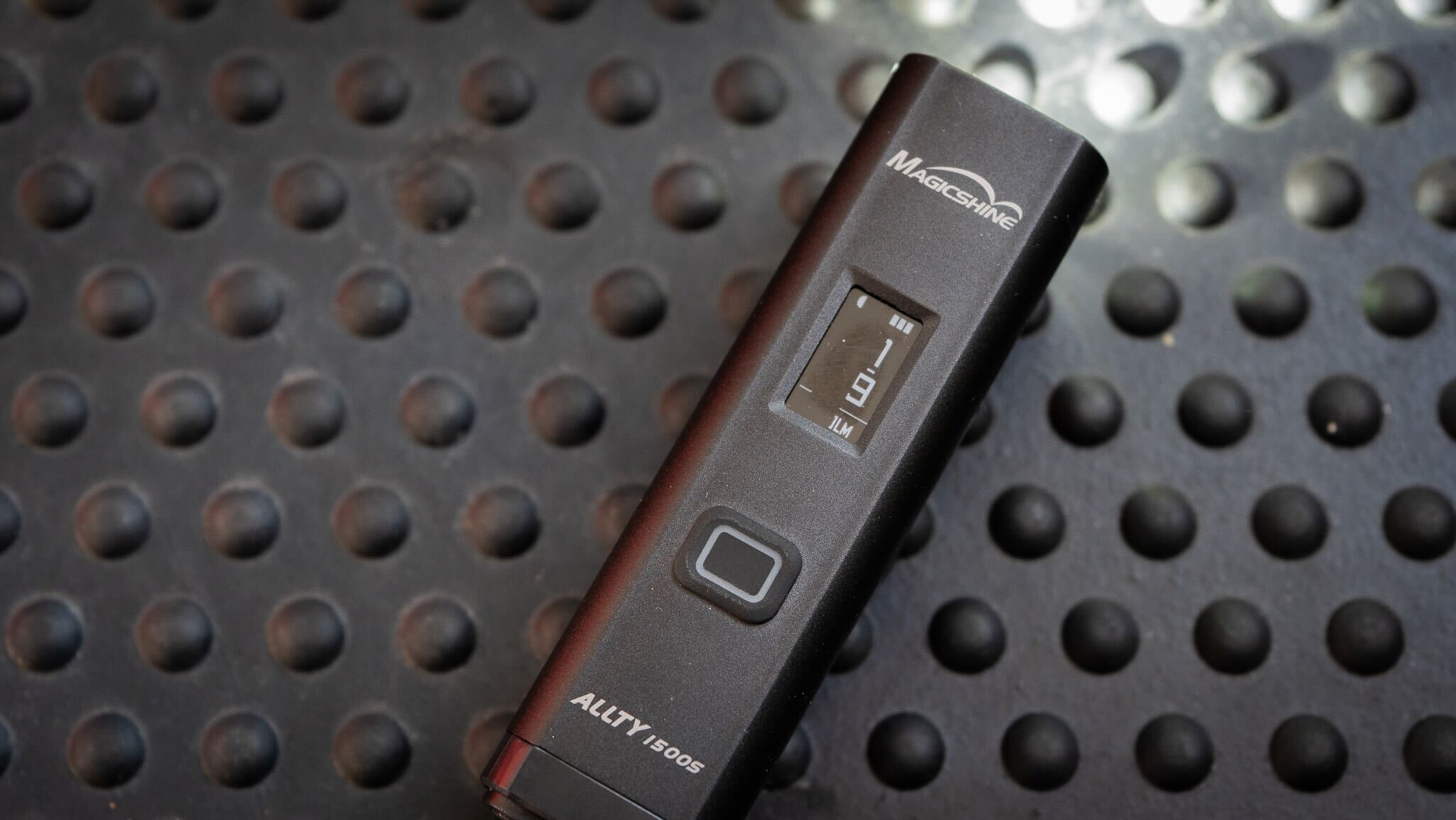
2. Magicshine Allty 1500s
Our expert review:
Specifications
Reasons to buy
Reasons to avoid
If you’ve never heard of Magicshine, you’re missing out. If you have heard of them but ignored them, you’re also missing out. They produce an impressive range of feature-rich lights, and this one, the catchy-titled ALLTY 1500s, is no different. It’s fancy. It features an OLED screen, similar to those found in your best smartwatches. It also features a Garmin-style mount and a decent bar-mounted clip with ample adjustability. It displays the battery level in precise percentages, and while the Raveman felt a little ‘edgy’ in some areas, this one, with a similar design in many respects, is of better quality.
This spec sheet stands out because the modes are all customisable via a pretty decent app. Although I initially thought this was entirely pointless—partly because I can cycle through the settings so easily on the screen—I find it fun to play with. I still believe it’s a bit overkill, given that the integrated screen shows you exactly what power output you’re accessing, which is very straightforward and genuinely helpful. I found that you can switch to the setting that best suits you, reducing the power where you feel you have plenty of visibility, and it provides a much clearer sense of control than almost all the other lights here.
The fitting system is a little fiddly, but once it’s in place, it remains secure and functional. This light earns extra points for having a swappable battery. Given that the internals of an LED light are quite ‘solid state’—without free-moving parts that might wear out—it seems likely your primary concern will be a battery malfunction. The fact that you can swap in a new battery without having to discard the whole unit is a big win for common sense.
At £89.99 and weighing 143g, it’s light in both weight and price, but it cannot quite top the Raveman, which has a better beam, and whilst it does have fewer features, it is a tenner less expensive than this unit.
Best front light for gravel

3. Cateye AMPP 2200
Our expert review:
Specifications
The new Cateye Ampp 2200 maintains the sleek, durable, and functional design of its predecessors, making it a reliable option in the premium bike light market. Its alloy body houses both the LED array and a 5000mAh battery, offering a longer, narrower profile that looks sleeker than some of the bulkier lights on test. Weighing 211 grams, it's the second heaviest light in this lineup, after the Exposure, but the extra weight comes from its larger battery capacity.
Mounting is secure and easy, with Cateye’s jubilee clip system fitting a variety of handlebar setups. The light itself clips into the mount securely and can be released in seconds. Extra brackets retail for just £6, making it affordable to share the light across multiple bikes or users in a household.
The Ampp 2200 offers seven modes: a turbo boost, three steady beams, and two flashing modes. At full 2200-lumen power, the light runs for 60 minutes, extending to 90 minutes at 1500 lumens and up to 60 hours on a daytime flash. Mode switching is simple with a single press for most settings and a double press for turbo mode.
The beam dispersion is excellent for both dark roads and general use, with a strong centre and good peripheral visibility. The light’s lens cut-out and side reflectors ensure visibility from all angles, adding an extra layer of safety for road users.
Competitively priced, the Ampp 2200 offers great value compared to its main rivals. It’s versatile, mounts securely, and is well-built. However, its IPX4 waterproof rating is slightly lower than some rivals, which may be a consideration for those riding in very wet conditions.
Best Front Light For Road Biking

The Blinder 900 is a sound option for commuters
4. Knog Blinder 900 front bike light
Our expert review:
Specifications
Reasons to buy
Reasons to avoid
I really liked the Knog Blinder 900 and think there is a good application for it. You just have to be clear about the sort of riding you’ll be using this light for. It’s simply not bright enough for bombing along at Tempo / Zone 3 through the still of the night - but it is plenty bright for riding at an Endurance / Zone 2 pace on even the darkest roads.
For a commuter light, post-work training ride or long-distance winter epics, this is perfectly sufficient. When I’m not really going to be pushing hard, after a day in the office or building a base. Plus, if your commute is mainly street lit, there’s simply no need for a brighter light than this as it doesn’t make a significant difference to what you can see.
With those parameters set out, the features really start to shine. First is the robust silicone band of the mounting bracket - I found this light is super easy to swap between bikes, taking a mere handful of seconds. There is still a quick release between the mount and the light, like all the other models on test - helpful when locking up in town.
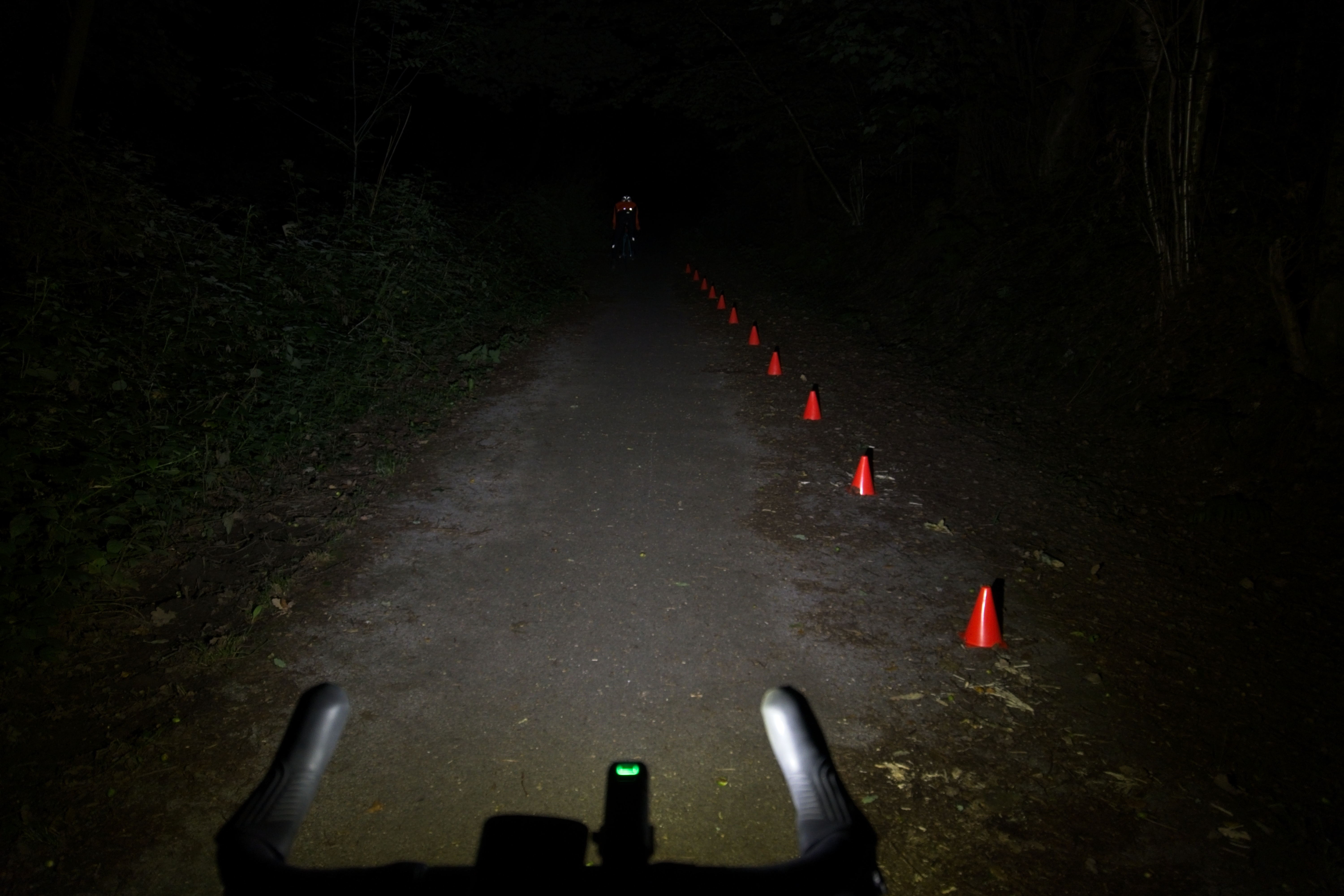
The battery lasts a handy two hours on full, and the charging port is USB-C, so there is good future-proofing. The downside is that the battery indicator is basic, remaining green for the most part and turning red at lower power levels.
A little more expensive than those lights from Magicshine and Ravemen, it would make more sense for most people to save money and go for the brighter lights. Still, given how easy the Knog Blinder is to attach and detach, along with its USB-C charging port, I can see a commuter situation where I would choose to spend the extra money and go with the less powerful Knog Blinder.
Best front light beam pattern
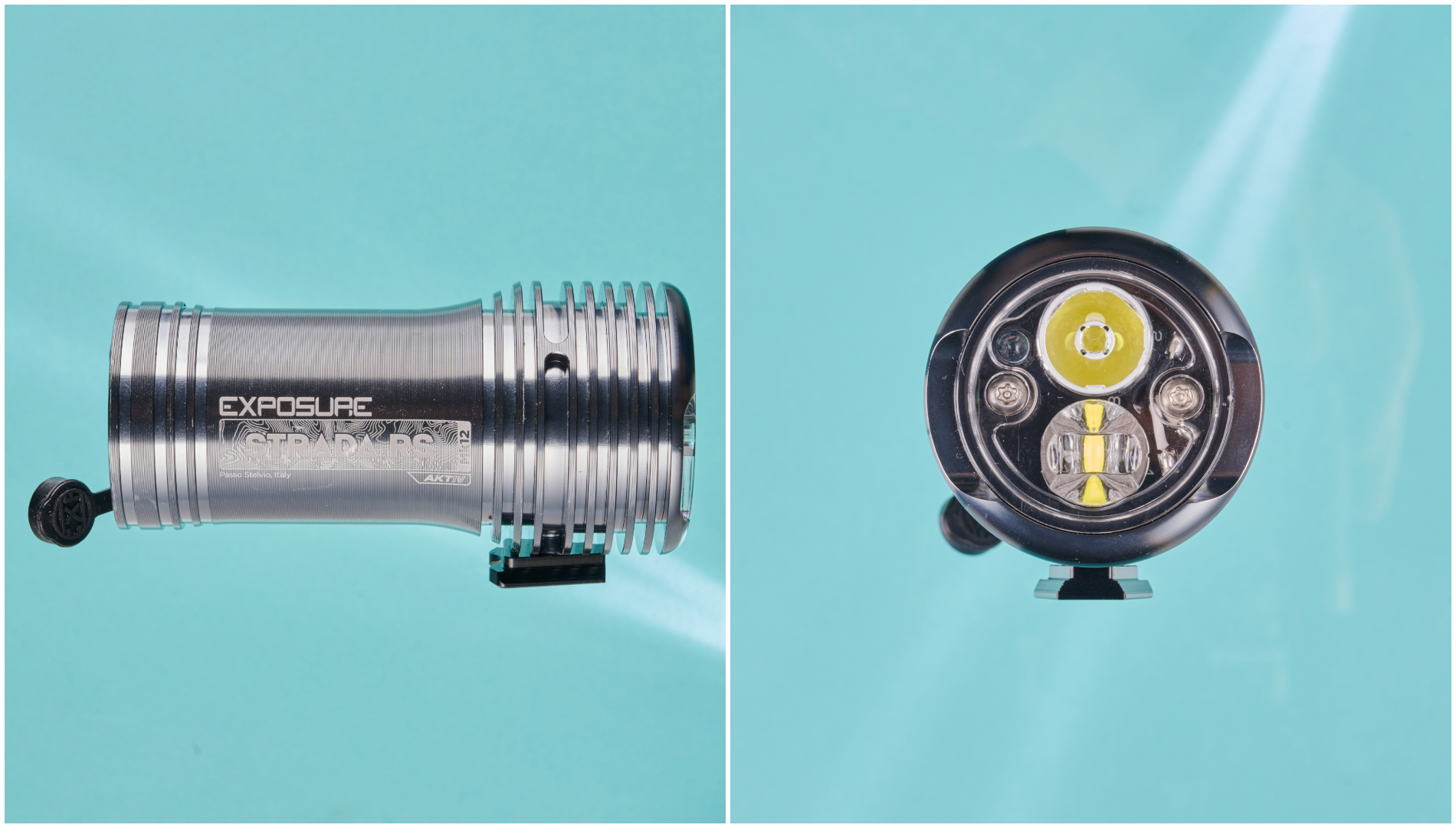
Exposure Strada MK12 RS AKTiv is both powerful and expensive
5. Exposure Strada MK12 RS AKTiv
Our expert review:
Specifications
Reasons to buy
Reasons to avoid
As expected, with its 1,450 lumen claimed output, the Exposure Strada certainly puts out a great deal of light - though it’s not the unambiguous winner in this regard. Despite being less than a quarter of the price, I found that the Magicshine and Ravemen both offered up a brighter central beam than even the Exposure Strada can muster.
As mentioned earlier, this is largely down to the Exposure light spreading itself more thinly, lighting up the sides of the road to a greater extent. This side lumination isn’t going to be an important consideration for all riders, but I find a greater light spread can make for a less disorientating feeling when riding in the dark.
Exposure’s system for controlling the lights with the single, brushed metal button is very neat and well-thought out - but it does take a little while to get used to. Magicshine’s system is more basic, but it is at least intuitive straight out of the box.
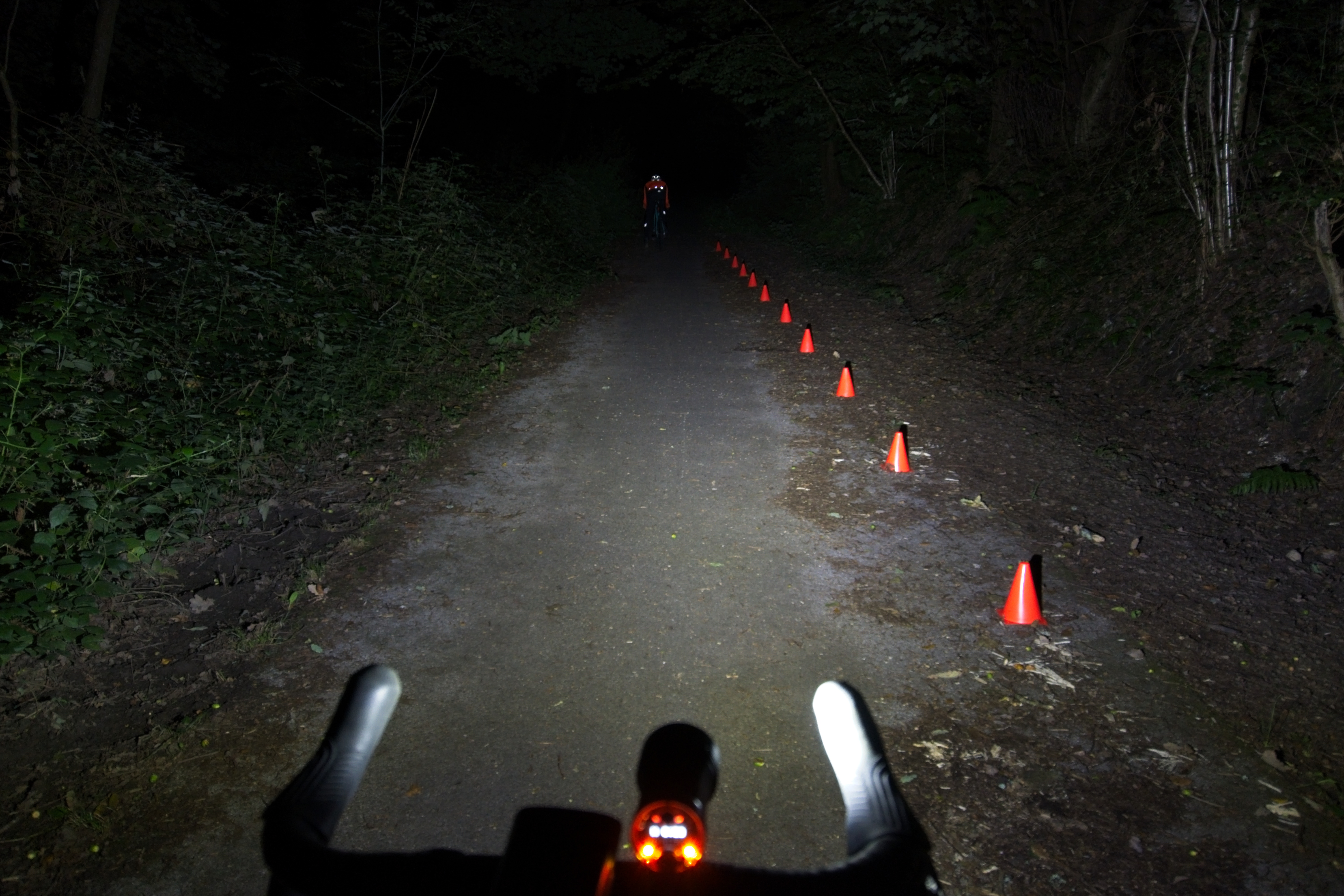
It’s a similar thing for the bar clamp - Exposure’s split-clamp system is exquisitely designed, with two CNC-machined pieces of metal slotting together to make the hinge and clamp. But it is rather more fiddly and harder to use than the simple-but-effective silicone strap of the Knog Blinder. The display on the rear of the Exposure Strada is a particularly neat feature of this light, displaying as it does the remaining charge of the light down to the minute.
Still, away from all the peripherals, fundamentally, the Exposure Strada remains a really, really good light. Like the Magicshine, I was happy barrelling along through the dark at full tilt, with the road ahead of me reassuringly brightly lit.
This model comes with Exposure’s AKTiv tech, which automatically dims the light when faced with oncoming traffic. It’s really quite seamless, with the light smoothly reducing its brightness and equally smoothly returning to full strength - it’s not like switching between the main beam of your headlights and the dipped beam at all.
With the light so bright, it is quite nice and reassuring having it dip when faced with oncoming traffic - you can be quite sure that you won’t be dazzling anyone. Then again, if you aren’t running a mountain bike light with a whopping 3,000 lumens and if you do have your light correctly set up, illuminating the road ahead of you, arguably, this tech isn’t so necessary. Still, it functions well, is an extra nice-to-have, and solidifies this light as a tech-packed de-luxe model.
One of the most enduring features of Exposure lights, away from the excellent performance of the beams, is their longevity. Like Assos cycling kit, you are paying for a build quality which really lasts and should be considered alongside the (proportionality higher) upfront cost. However, against competition such as Ravemen and Magicshine, it’s hard to recommend that everyone should spend that much more for Exposure's quality. But if you have the money to invest, you won’t be disappointed.
Best budget front light
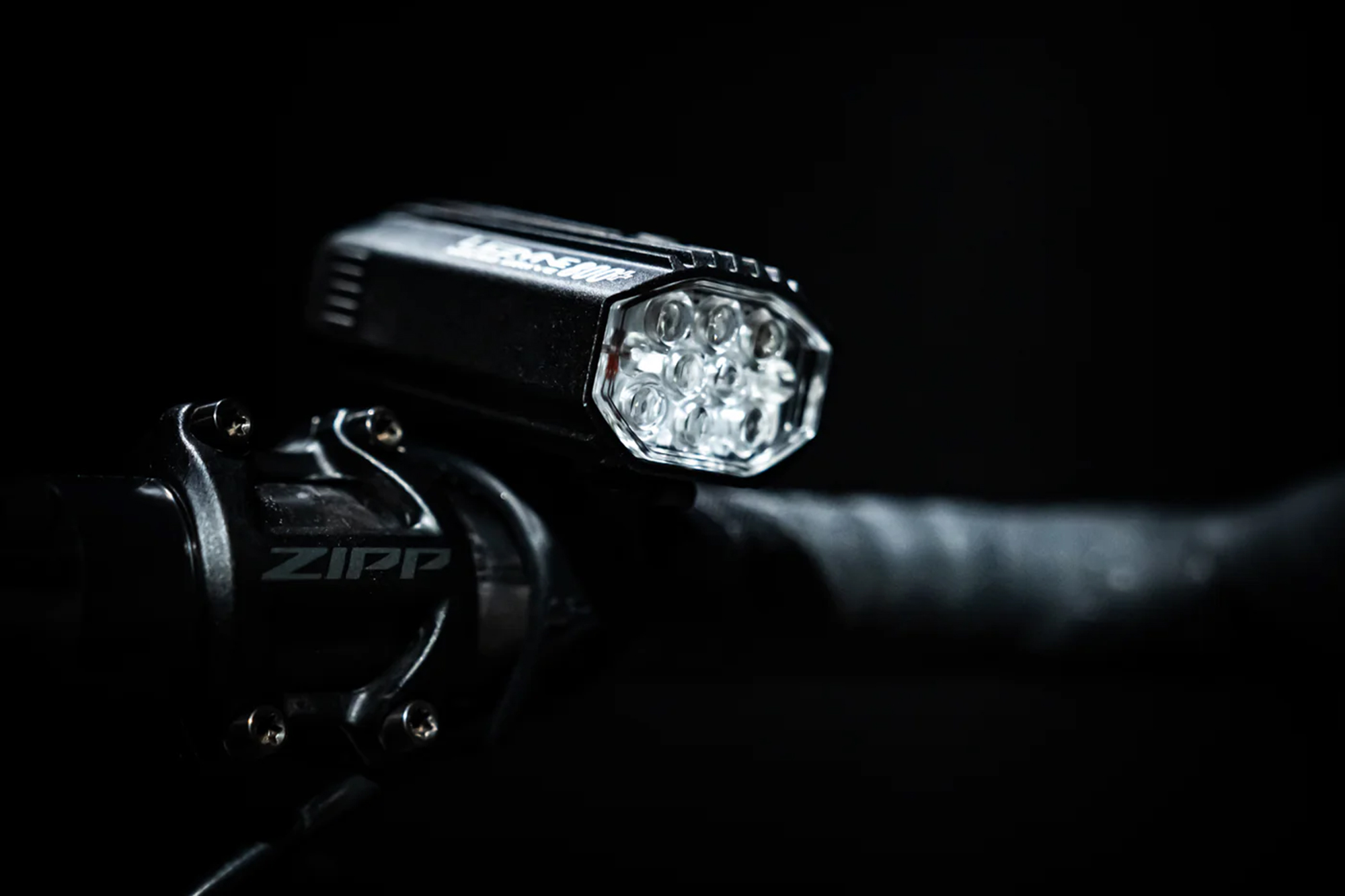
6. Lezyne Micro Drive 800+
Our expert review:
Specifications
Reasons to buy
Reasons to avoid
The Lezyne Micro Drive 800+ is the smallest, lightest, and least powerful light in our most recent test, offering an interesting contrast to its heavyweight competitors. With a maximum output of 800 lumens, it’s just enough for riding on unlit roads and paths. Despite its modest power, the Lezyne punches above its weight, weighing only 133 grams, including the rubber strap mount, making it barely noticeable when attached to the bike.
Its compact size is a major advantage for commuters or those who leave their bike unattended, as it's easily removable and small enough to stow in a pocket. The Lezyne features a straightforward six-mode system, including three solid beams and three flashing options, all accessible through a single button. On full power, the light offers a two-hour runtime, which is sufficient for commuting or a post-work ride. In its most economical mode, it can run up to 35 hours, or 30 hours on the 700-lumen day flash setting.
The build quality is solid, with an alloy chassis and a plastic rear cap. While it doesn’t have the same premium aesthetic as higher-end models like the Cateye or Knog, it’s functional and well-designed. The only notable drawback is the removable charging port plug, which could be easily misplaced.
Overall, the Lezyne Micro Drive 800+ is a well-priced, versatile light that is ideal for a wide range of riders. Its lightweight design, solid performance, and easy portability make it a strong choice, particularly for commuters or those seeking a compact light with decent power.
Best rear bike lights
The best rear light overall

Magicshine's SEEMEE300 is packed with tech including an inbuilt motion sensor
7. Magicshine SEEMEE300
Our expert review:
Specifications
Reasons to buy
Reasons to avoid
The SEEMEE300 is an incredibly tech-packed light - as well as hitting a competitive price point. It’s really very impressive what Magicshine has done with this light, so let’s run through each of the features in turn.
First, the fun stuff. An increasing number of rear lights have these features, but Magicshine isn’t to be left out - the SEEMEE300 has an inbuilt motion sensor, with the light shining its full 300 lumens when it senses the bike is braking (the highest ‘constant’ setting is 100 lumens).
In addition to that, it also shines a circle of light onto the ground behind you, boosting visibility from every angle. The main light itself has a side cutout to increase the angle of visibility to 260 degrees - which is high in itself, although not the highest.
The mounting system is one the best I’ve ever used, with a thick silicone band that holds the light firmly in place (and on a variety of seatpost depths). But it also has a quarter turn mount, making it quick and easy to remove the light when wearing gloves in the winter - whether taking it in for charging, or when popping into the shops.
Then there’s the battery life, which is on another level. Even on the highest ‘constant’ setting, the claimed run time is six hours. When on the ‘low’ setting - which is still 20 lumens! - that goes out to a whopping 40 hours.
For me, there is one slight idiosyncrasy in that the light can sense the ambient light condition and adjust its beam accordingly - but the light goes brighter at night and dimmer during daylight. Personally, I’d want the brighter light in the daytime in order to stand out better - a light doesn’t have to be super bright to be highly visible at night. On the other hand, at least the daytime flash setting does make full use of all the 300 lumens.
In all, it’s a highly impressive light with a host of clever features and nice touches. The fact that the price is so competitive makes it the first choice in most cases.
The best rear light for viewing angles
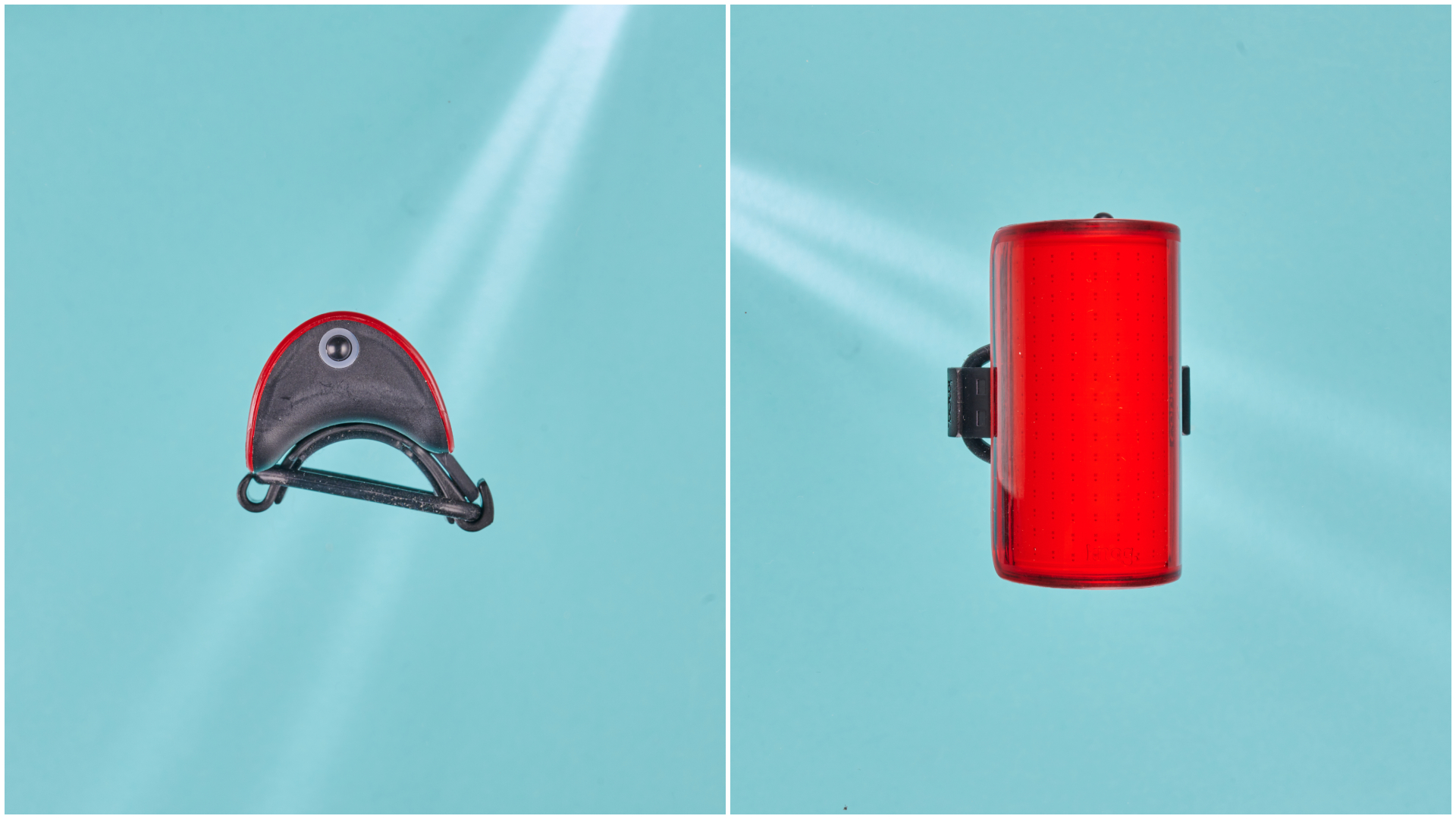
Thedistinctive looking Knog Mid Cobber rear light
8. Knog Mid Cobber Rear Bike Light
Our expert review:
Specifications
Reasons to buy
Reasons to avoid
The Knog Mid Cobber has a few really nice features which make it stand out against the crowd - but it also has a few limitations which put it out of the running for ‘best overall’.
In terms of the good, the Knog Mid Cobber has the widest angle of visibility out of all the lights on test - the distinctive curve of this light is instantly recognisable as a Knog, and it gives a whopping 330 degree range of visibility directly from the light.
The silicone O-ring is stretchy, strong, and can easily accommodate a range of seatpost depths. Being an O-ring, it’s hard (for me, impossible) to remove the light without removing your gloves first. But once you do it is quick to swap between bikes.
Finally, the Mid Cobber has built-in USB charging, so you don’t need to remember a cable - but you do need a USB port to plug it into and the light itself is pretty bulky. For some people cable-less charging is a must-have deal breaker - for me, I prefer USB-C and the flexibility of a cable.
In terms of the not-so-good, the battery life isn’t great. The highest constant setting is 75 lumens (the full 170 only happens in some flashing modes) and this only lasts for two hours. Even the lowest constant setting at 35 lumens - which is still brighter than I think is necessary - is only 3.5 hours.
The flash settings do give you longer run times but, when riding at night, in many countries it’s a legal requirement to have at least one constant rear beam. And with good reason, it’s harder to track the motion of a vehicle/person when there isn’t a fixed source of light. So those short run times are a bit of a shame.
The price is also higher than the excellent Magicshine SEEMEE300, and with that light being so good in so many respects, most people will get better value from the cheaper option. But, if you like the wide visibility angle and the cable-less charging, the Knog Mid Cobber could be an option for you.
The best value rear light
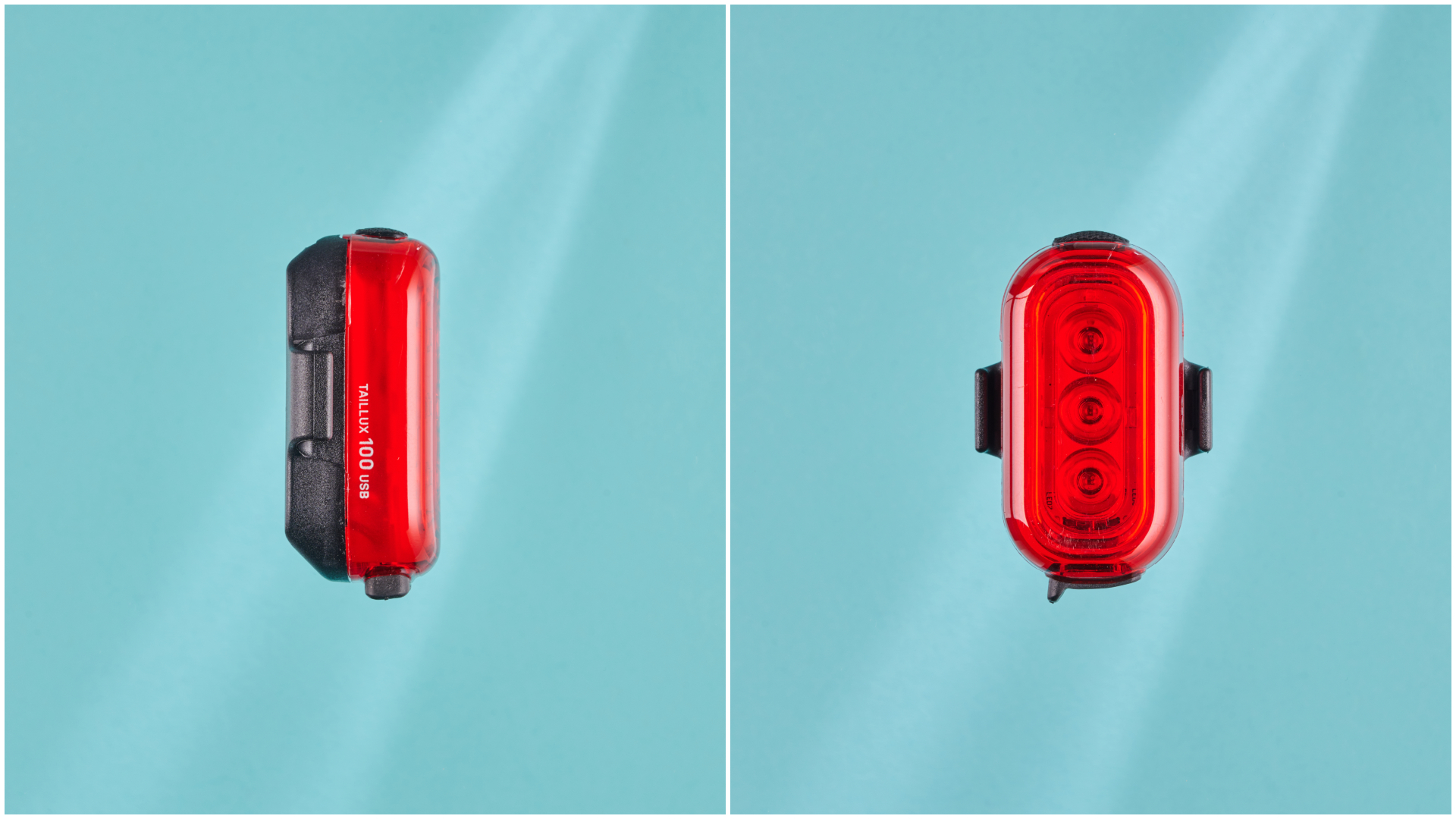
Topeak's Taillux 100 is a great value rear light
9. Topeak Taillux 100 USB
Our expert review:
Specifications
Reasons to buy
Reasons to avoid
The Topeak Taillux 100 doesn’t have the bells and whistles of some of the other lights on test - but it does the fundamentals very well, and comes in a little cheaper as a result.
The maximum brightness is 100 lumens and the burn time is listed as three hours on that mode, which is respectable, though not class-leading. In the arms race for ever more lumens, to have 100 on a rear light is pretty standard these days. But it is well beyond what is really necessary for being seen - during testing I never felt the need to run the light on full blast.
Fortunately, there is a mode which sees the three centre lights stay constantly lit, but the bright outer ring blinks in a sequence. I really like this sort of setting, as you get the constant beam which makes it easier for people in cars to track your movement - but you also are more likely to catch their eye with the flickering light. Even better, this bumps the battery life up to a healthy 10 hours.
The mounting is via a silicone band, which accommodates seatposts of varying depths, as well as making it easy to swap between bikes. You can also use the light with a clip, which makes it possible to attach to the light loop of a saddle bag or similar.
Charging is via USB-C which is nice and up to date. And the viewing angle is 220 degrees, which is respectable, although again not class leading. There are no features such as brake or ambient light sensing. On the other hand, it’s light and a bit cheaper. If you don’t need the extra tech, this is a great option.
Best daytime running rear light

Raveman's TR500 excels as a daytime running option
10. Ravemen TR500
Our expert review:
Specifications
Reasons to buy
Reasons to avoid
The Ravemen TR500 is a pretty close contender for being best on test. Starting with the best stuff, the ‘warning flash’ setting is exceptional for daytime riding. This chucks out a whopping 500 lumens with an eye-catching and rapid flash - if you’re concerned about riding at sunset, or are just after the maximum visibility at all times, this is an excellent option.
Like other lights on test, the maximum lumens for the constant beam are 100 and with a 4.5 hour runtime on that setting, it’s second only to the Magicshine SEEMEE300. But with 20 lumens of the ‘low’ setting are plenty, and on that setting you get a hefty 17 hours - again, second only to Magicshine.
Although it doesn’t have an ambient light sensor, the Ravemen TR500 light does have an accelerometer and I like how it brightens when you brake. The light attaches using a silicone strap, which I found simple and straightforward to use, making it easy to swap between bikes and accommodate aero seatposts. The light also charges by USB-C.
Were it not for the Magicshine SEEMEE300 with its longer battery life - and also its floor-directed beam for full 360 degree visibility, the Ravemen would be top of this list overall. But even so, that super-bright 500 lumen flash means that this is hands down the best daytime running light on test.
Best compact rear light

Bontrager's Flare RT is compact but still has plenty of features
11. Bontrager Flare RT
Our expert review:
Specifications
Reasons to buy
Reasons to avoid
This is a great little light with a solid range of features. Despite its diminutive size, it can still put out up to 90 lumens - although only on the flashing setting. With a constant beam, that brightest setting is 25 lumens and a run time of only 4.5 hours.
This goes out to 13.5 hours on the lowest light setting, but that only comes to five lumens - which is a little too dim for me! In a more urban setting, I don’t feel like that’s bright enough to really stand out against the street lights, traffic lights and the head and tail lights of passing traffic. On darker lanes without so much other light pollution, arguably those five lumens stand out better, but with the higher speed of traffic on country roads, I don’t feel this is sufficient.
So the 4.5 hour run on ‘high’ is basically as good as it gets for night riding - but for commuting duties and evening rides, that is all that’s needed. The daytime flash mode is pretty good with those 90 lumens and a six hour run time, at least considering the size of the light.
And the size of the light is essentially what this all comes down to. Either you want a smaller and less obtrusive light, and are happy to put up with less battery life, or the shorter battery life is going to be a sticking point and you’ll prefer something larger with more juice.
The attachment system is with a silicone strap, but there’s also a quick-release lever, making it a bit quicker and easier to take the light off if you’ve stopped off somewhere or just need to take it in to charge. It’s not as easy as a quarter-turn mount - with gloves it’s a little fiddly but do-able. The charging is through micro USB, which is a little old-fashioned at this point, but with so many devices still using the standard, it’s not dead yet.
In all, this light suits someone who prizes size above all else. The brightness is perfectly serviceable for both daytime and night-time use, it’s just the battery life is a little low and there isn’t much in the way of extra features - such as an accelerometer or visibility boosting from a range of angles. At the same price as the Ravemen TR500 and the Magicshine SEEMEE300 - as well as being more expensive than the Topeak Taillux 100 USB, it’s a pretty specific use-case where this one comes out top.
Best rear flash
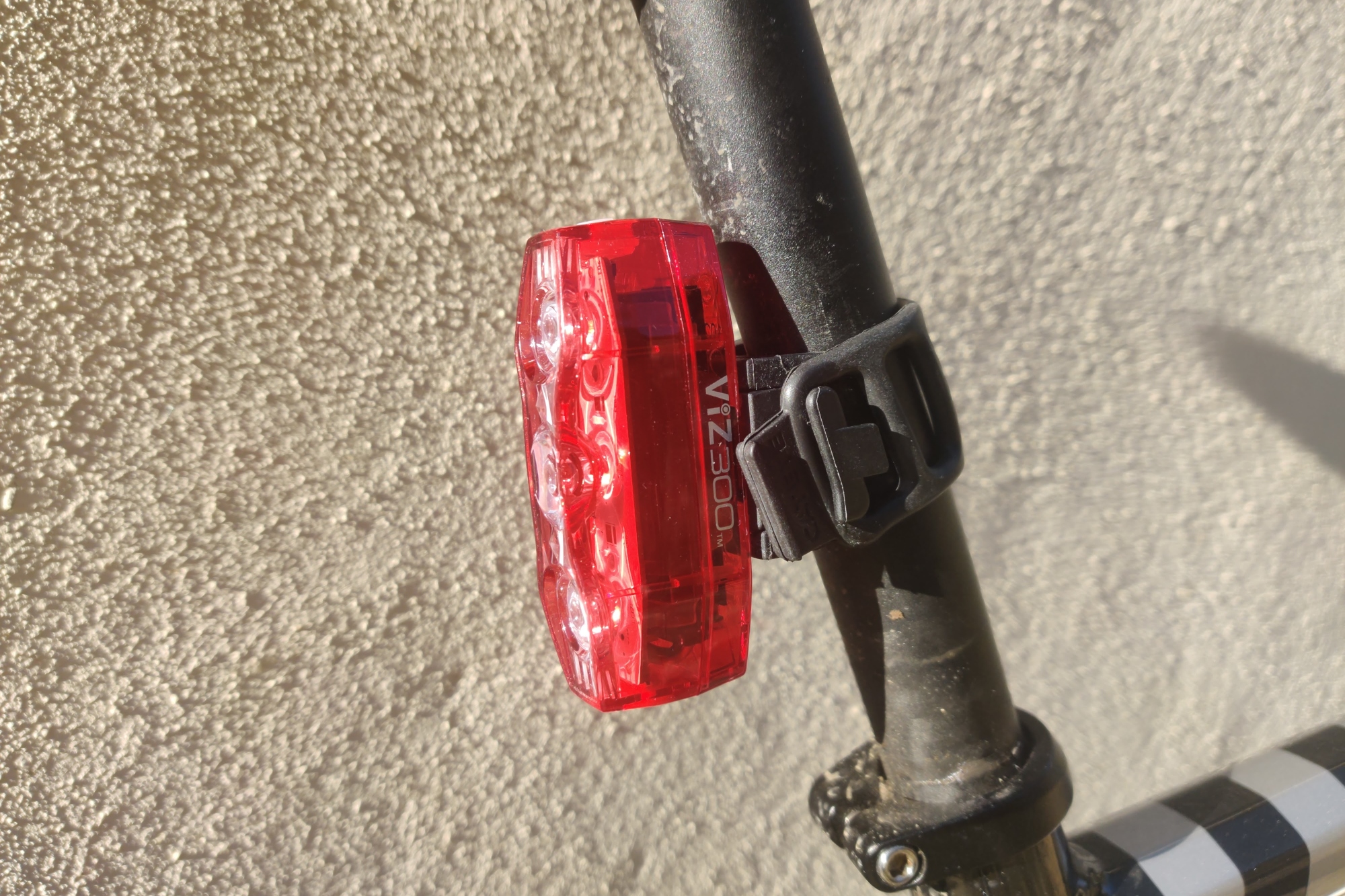
The ViZ300 is certainly bright but also a little fiddly to mount
Specifications
Reasons to buy
Reasons to avoid
Bright enough for all applications and a good choice of modes makes this a great choice for most serious riders. We particularly like how the ViZ300 has a 100 lumen mode lasting eight hours, helping to make long winter rides that much safer. Alternatively, 45 hours on a single charge will keep most commuter users satisfied without charge for well over a week.
Three powerful LEDs make up the lighting array for this light. CatEye has incorporated good lensing and a nice clear case allowing for viewing angles of 300 degrees - so no blind spots for tailing drivers. Not that it comes on all too regularly, but the light also features a low battery light in the function button so you can see when a charge is needed.
Read more: CatEye ViZ300 rear light full review
Best Bike Light Sets
Best bike light set overall
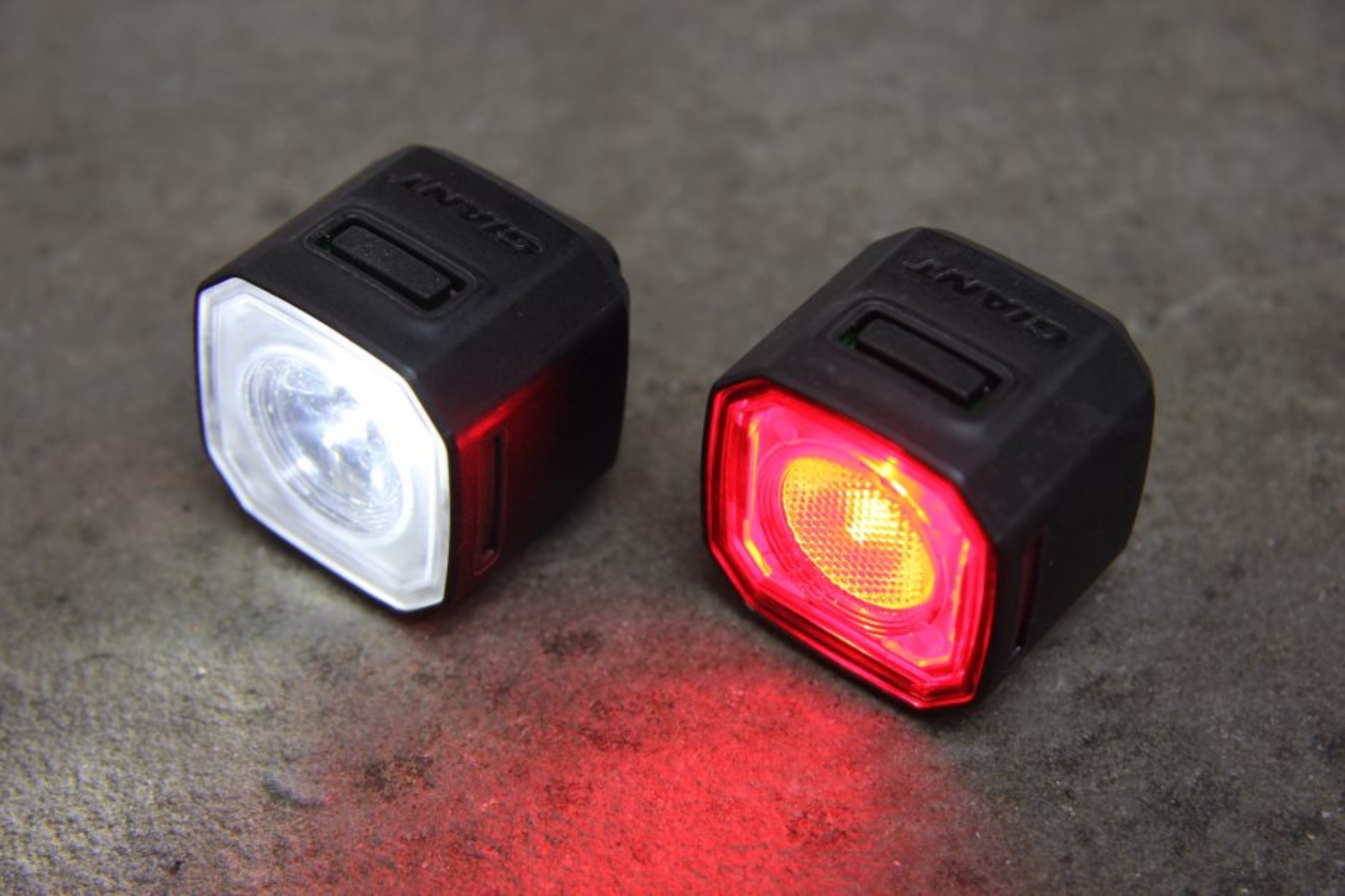
The Giant HL 100 and TL 100 Combo lightset is simple and easy to use
Specifications
Reasons to buy
Reasons to avoid
The Giant Recon HL 100 and TL 100 are very simple to operate, with no long presses or counting flashes to determine brightness level or anything like that. You just cycle through the five modes by short-pressing the on/off button and it’s the standard long press for on and off.
The switch, however, is a small oblong that needs direct pressure in exactly the right place. A protruding, rubbery switch would be easier but it would wreck the cube’s symmetry. I can live with form over function this time, but sometimes it takes a couple of attempts to activate it, especially with gloves.
The Tail-Light (TL) is surprisingly bright – blinding even – for such a small light. It’s really all you’d ever need from a rear light. The Head-Light (HL) is fine for streetlit commutes but is not enough for seeing on unlit roads – it is strictly a ‘be-seen’ light.
Landing in the middle ground price wise, they're well designed and have good functionality. Perfect for a lightweight, versatile, good-looking, commuter light set with a very useful daytime mode.
Read more: Giant Recon HL 100 and Recon TL 100 combo review
Best high power light set

The Lezyne Micro Drive 600XL and KTV Pro light set is solid and secure
Specifications
Reasons to buy
Reasons to avoid
At 600 lumens, the Lezyne 600XL packs a punch and isn't far off being a 'seeing' light.
The front 600XL uses a permanently attached rubber strap to wrap it tightly around the handlebar but it also rotates on the clamp allowing you to fit on a fork leg or any odd angled position. Despite being used on the fork leg for long distance riding, we had no issues with the light remaining steadfastly in place.
The LEDs are arranged in a side-by-side pattern and push out a decent spread of light that in most modes works as a flood light to light up the road ahead evenly. Only in the two brightest modes does it take on more of a spot pattern, highlighting a smaller but brighter patch of the road ahead. But we can attest that even the lower flashing modes are bright enough to light up road signs from over five hundred metres away easily.
With regards the rear KTV unit, mounting is reliant on the thick rubber strap and slightly compliant rear recess on the light body. This recess is a little too narrow and the rubber a little too stiff to hold it tight against a standard seatpost. This does result in the light twisting off centre during a ride and reduces rear visibility. Something you will need to keep an eye on.
Read more: Lezyne Micro Drive 600XL and KTV Pro light set review
Best set for ultimate quality
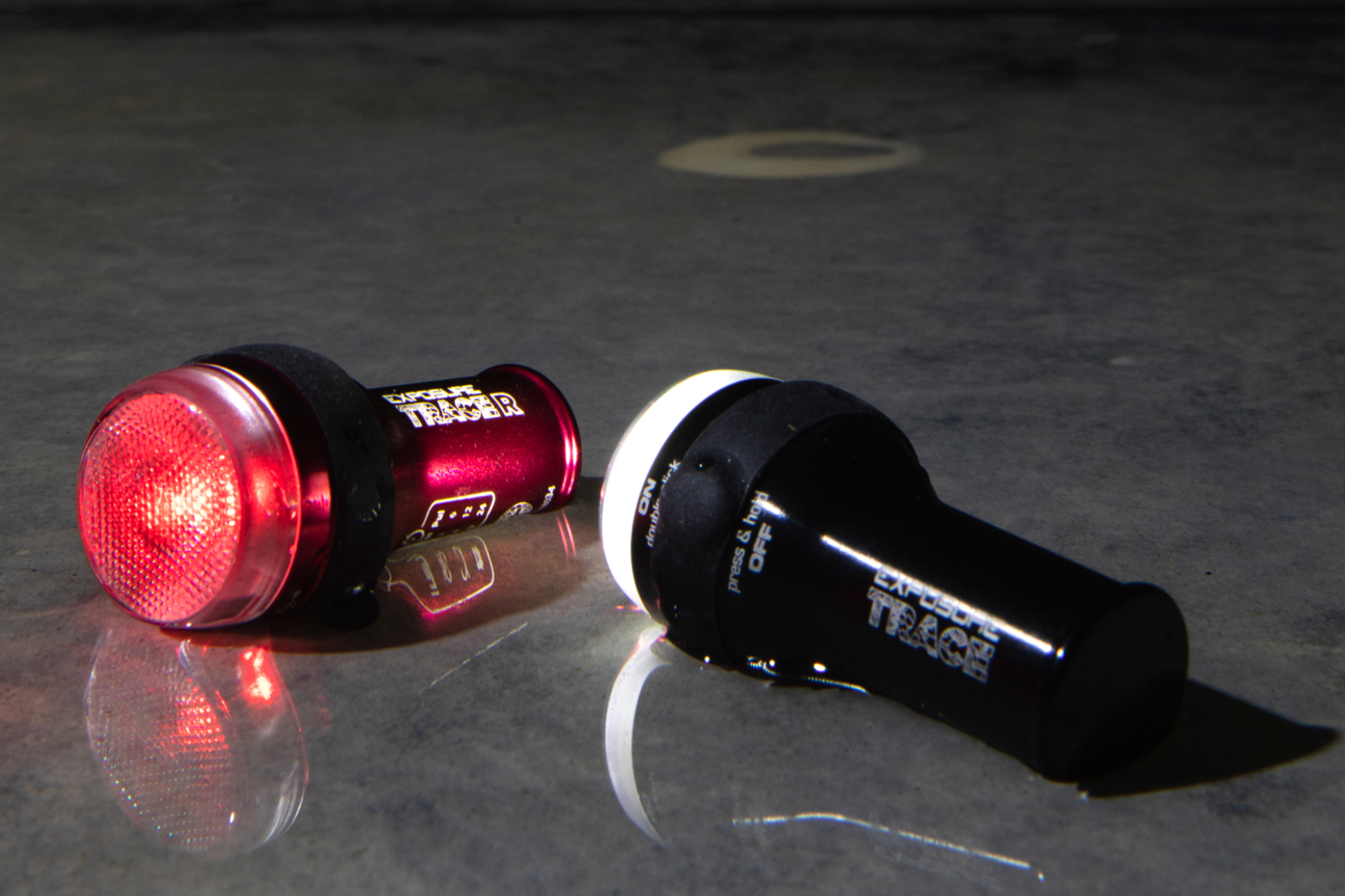
Exposure Trace lights are a long term favourite in the Cycling Weekly office
Specifications
Reasons to buy
Reasons to avoid
The Trace and TraceR lights are the smallest and most featherweight units Exposure produces and at first glance it's hard to imagine the sort of performance they are capable of. But just like David against Goliath, size isn't everything.
Tiny, robust, extremely bright and with long burn times, there really is nothing to fault the Exposure Trace and TraceR light set. Ideal for everything from commuting to being a backup set for longer trips, this is a set of lights that will provide reliable service for many a year.
The beam pattern and visibility for both lights are exceptional. The front throws out a good spread of light and in flashing mode easily lights up road signs for a few hundred metres ahead and the rear daybright mode is searingly bright. Both lights also have an extended lens that enables them to throw out a good level of side visibility, extending the safety levels.
Charging is simple and it takes just 1.5 hours to charge each from empty. A USB charging port is located under the rubber band that encircles the light. It can be a bit fiddly to pull it out of the way but you soon get used to the process. We’re yet to have any water ingress so despite its flimsy appearance it works really well.
Read more: Exposure Trace and TraceR MK2 light set review
Best Rear Radar and Smart Lights
Best Rear Radar Light
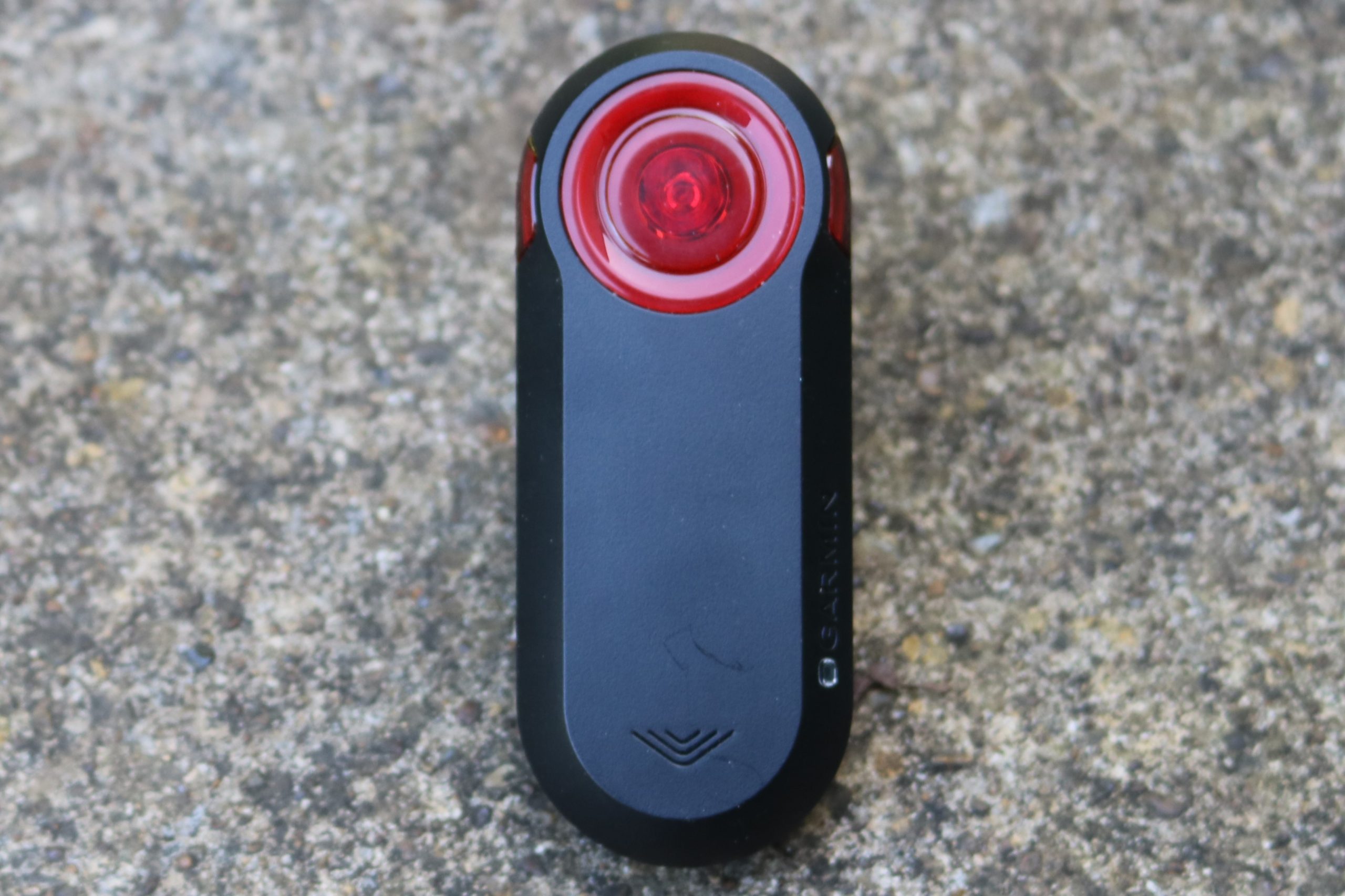
Garmin Varia RTL515 comes loaded with safety features
Specifications
Reasons to buy
Reasons to avoid
Garmin's Varia RTL515 has four light modes, 65-lumens under the hood, and has a viewing angle of up to 220-degrees, but that's not what sets this light apart.
Hidden inside this sleek looking taillight is a rear-facing radar which can pick up cars from up to 140m / 459ft away, and when connected to a Garmin, Wahoo or other brand head unit, alerts you to and tracks cars as they approach. It may sound like a gimmick, but in our experience, it is surprisingly accurate, and often picks up cars before our ears do.
The radar also means that the light can change its lighting pattern as a car approaches, flashing more brightly and more rapidly to make certain that you're seen.
There's a robust mount that can be converted to fit different shaped seatposts and an app to configure the light and which acts as a head unit if you don't have a bike computer.
Read more: Garmin Varia RTL515 review
Best budget rear radar light
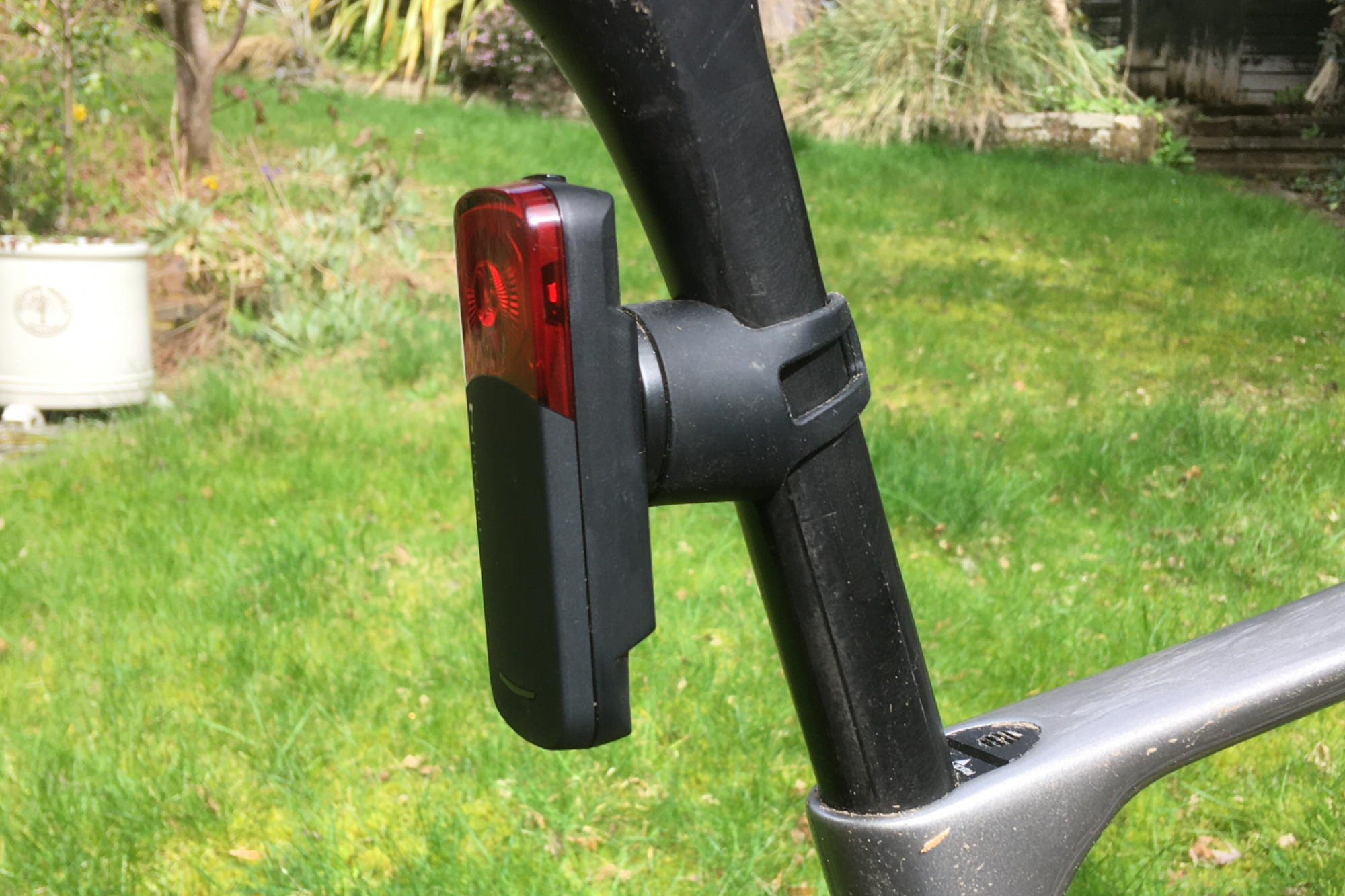
Specifications
Reasons to buy
Reasons to avoid
The R300L is the first rear light and radar unit from Bryton. A built in G-Sensor can detect braking and change the light output accordingly, but it is the addition of radar that is the most interesting development.
The unit can detect vehicles from around 150m behind, alerting you with a bleep as well as a visual change to the side bar on your head unit display, then, as the car approaches you, an icon moves up the side bar until it is near the top of the screen. Then you know that it is a short way behind you. Once the 'threat' has passed you or turned off, the unit bleeps again and the side bar turns green. Multiple vehicles can be displayed on your display too.
The great thing about this technology is how surprisingly useful it can become. You can concentrate on the road conditions more and then look down when it is appropriate to do so, having been alerted by the bleep. Then a look behind can be usefully deployed as necessary.
We found that the light is good, albeit not as great as the class leading lights, and it also has decent battery life. The light can be turned off completely, as it is able to be run solely as a radar unit, with a 24 hour battery life in that mode. The seat post bracket feels nicely secure and it locks the light on well, and conventional round, aero and D-shaped posts are catered for. It is priced very keenly for what it offers.
Read more: Bryton Gardia R300L Rear Light & Radar full review
Best Garmin Varia Alternative
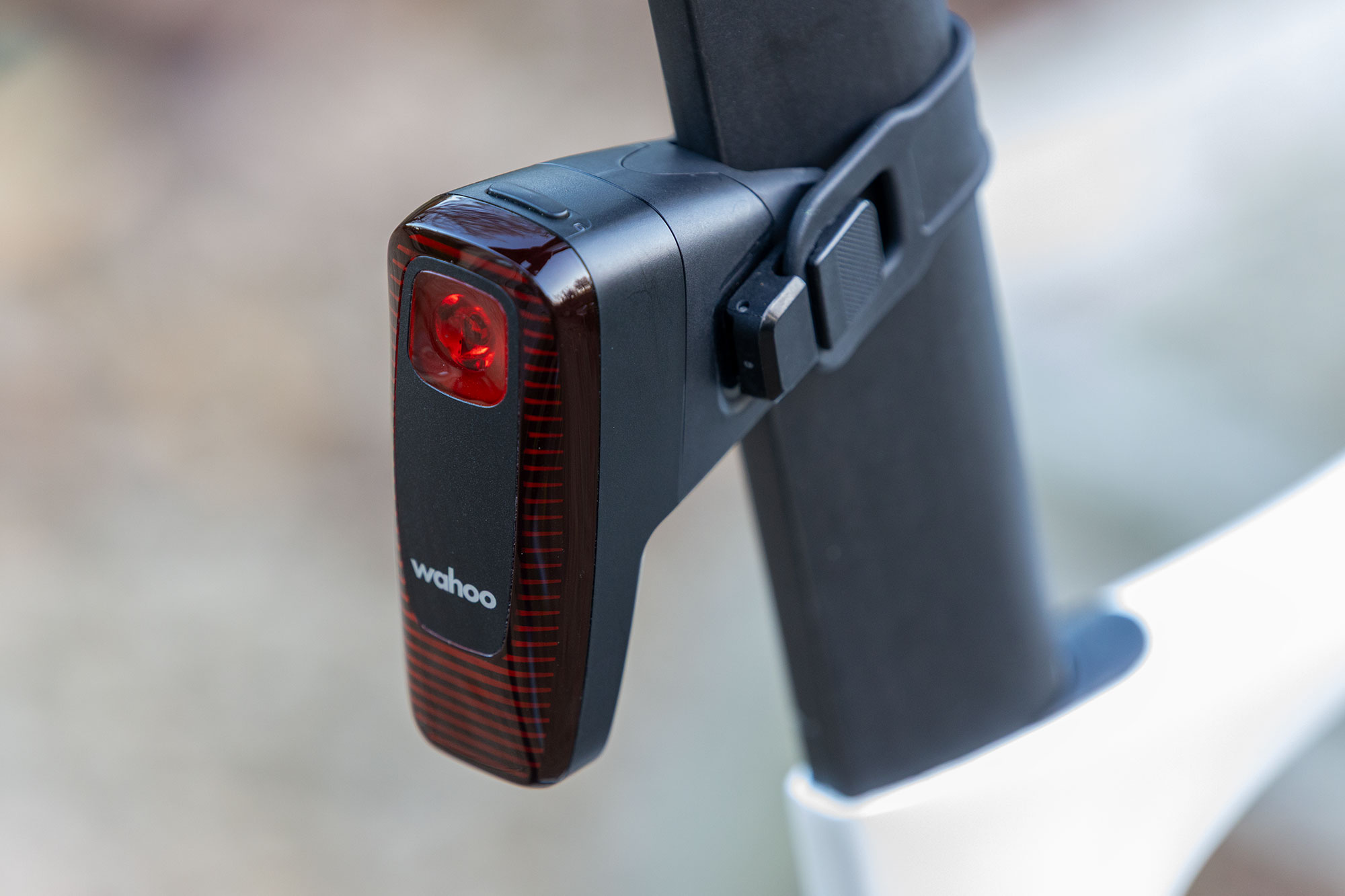
18. Wahoo Trackr Radar
Our expert review:
Specifications
Reasons to buy
Reasons to avoid
I’ve been using radar bike lights for about five years. At first, I thought the Garmin Varia was a bit of a joke, but I became a fan. Now, I'm so sold on this tech that I bought Garmin Varia RTL 515 units for my wife and kids.
So, when Wahoo launched its Trackr Radar in spring with the Roam 3 and Bolt 3, I had to check it out.
I found the initial setup very straightforward, and pairing to the new Wahoo Roam 3, which I also tested, was simple. I also tested pairing with Garmin units, specifically the Edge 1040 and 1050, similarly easily. Wahoo does recommend pairing to their app first, though, for software updates, etc.
There is two reasons really I see for choosing the Trackr Radar over the Varia. First, the Trackr is a more feature-rich light, with a brake light, long battery life, and a much greater detection range. However, it does have an Achilles' heel: the radar's radius at which it can sense movement. Once the roads start to wind and you're riding in a group, it certainly seems to have a narrower field of view, despite outperforming Garmin in overall distance.
That said, given the cost is much for muchness and you do get a whole heap more than the Garmin, I would highly recommend the Trackr.
How we test bike lights
Several methods exist for testing bicycle lights, the most common of which involves measuring a light's power output. Typically, this involves using an illuminance or lux meter, which provides Lumen and Lux output values. Conducting these tests requires a controlled environment to ensure repeatable conditions, which I currently lack access to, though I hope to pursue this testing in the future. Most brands have likely conducted these tests already, and I trust their accuracy.
When I evaluate a light, I assess its performance during rides on the road and trails. The best way to determine if a light suits your needs is to use it in real-life situations. First and foremost is build quality; can it endure drops or tolerate being stored in the bottom of a work bag? Is the mount sturdy enough to handle bumps at the bike rack? Is it easy to install and remove for use on different bikes? I also consider how long it takes to charge the light, as well as the duration of that charge. Additionally, I examine its performance in varying weather conditions and whether there’s a noticeable decrease in functionality when temperatures drop.
The crucial test for me is determining whether I am visible and can see well. To achieve this, I consistently repeat the same test with each light. I also ride the same route under similar conditions and times to maintain a constant traffic flow, providing a solid baseline. This involves riding in towns or cities, as well as on quieter lanes and trail tracks.
For more information on how we test all our products, visit our How We Test page.
Meet the testers

On the dark, quiet lanes of Norfolk, Andy needs his lights not just to make him visible to vehicles; he needs to be able to see ahead. If you have never visited Norfolk, you should; however, the twisty roads are potholed, and while it's beautiful to have so much nature, from time to time, it will run out in front of you. This makes Andy best placed to really put bike lights to the test, especially when he is regularly riding unfamiliar tech and kit.
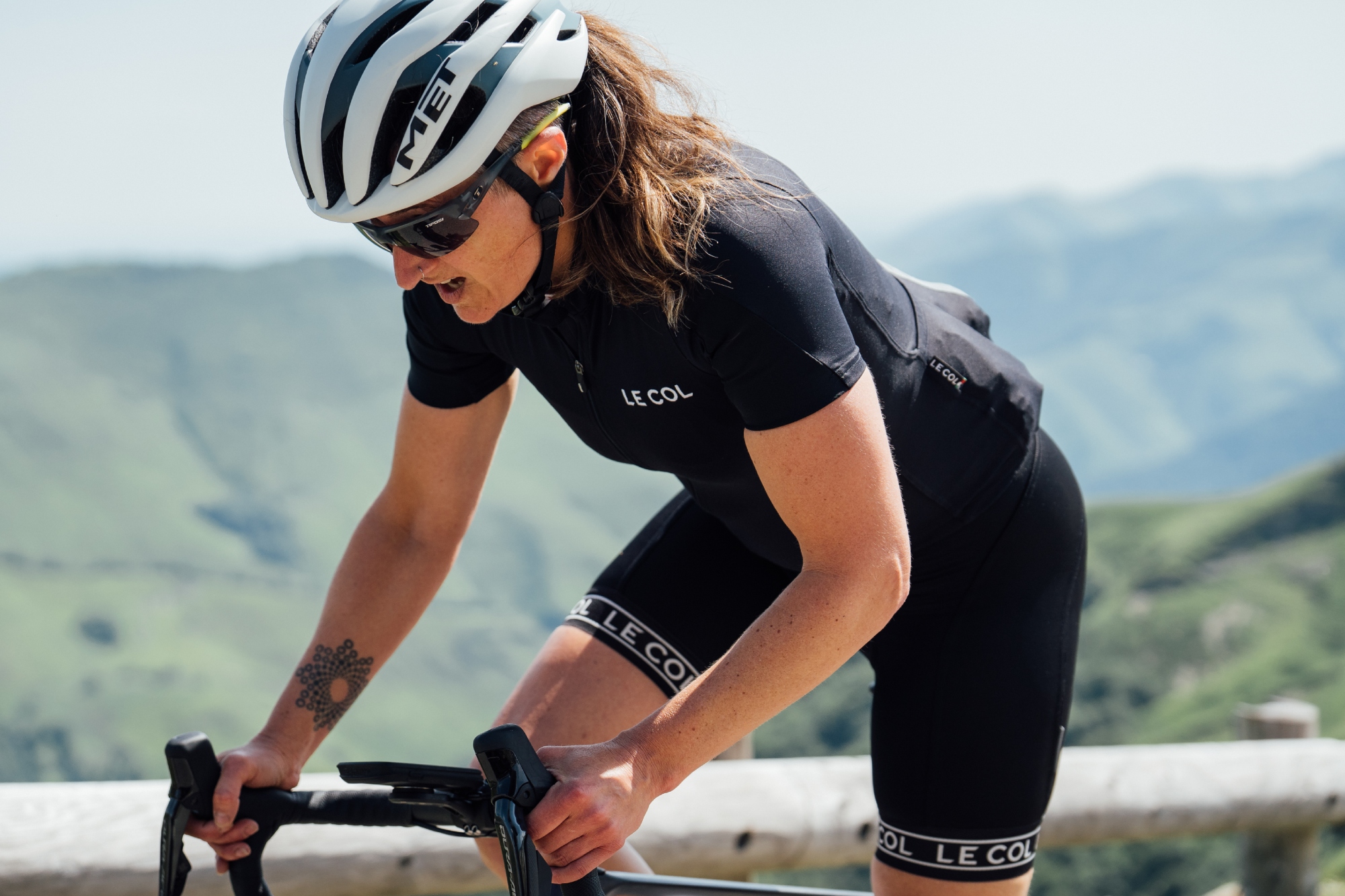
Hannah is Cycling Weekly’s longest-serving tech writer, and has been writing news, features and evaluating the latest cycling tech for nearly 15 years. Hannah is based just outside the Peak District here in the UK, making her ideally located to put the best bike lights to the test. Not only is the Peak full of dark country lanes strewn with tree branches throughout the winter months, but being further north than much of the team means she consistently experiences less-than-favourable riding weather. This allows her to really put reliability and build quality to the test.
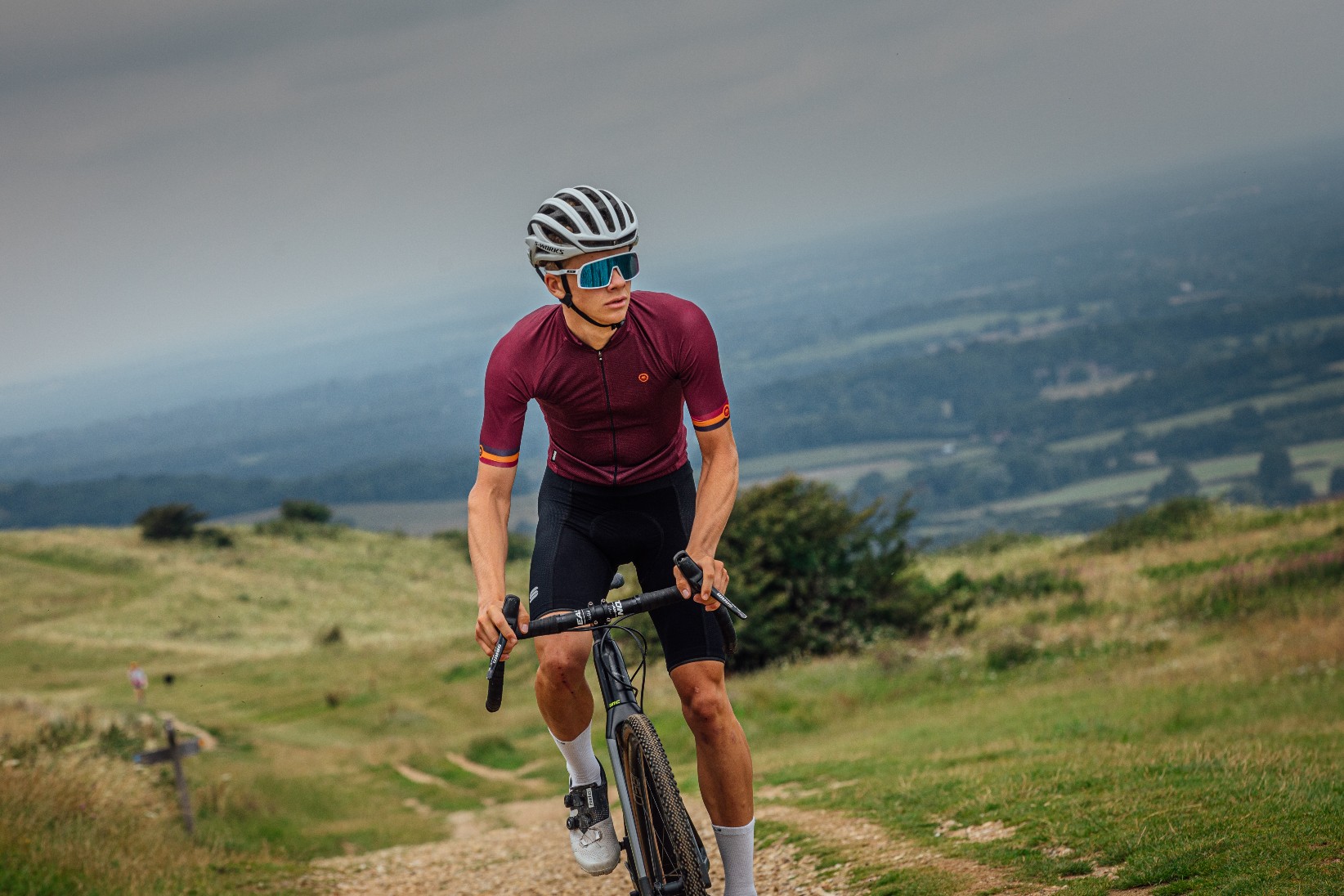
Joe is an ex-racer and prolific bike rider. You might wonder how that makes him knowledgeable about lights. Joe is more than happy to regal stories of the days grinding away in all weathers and at all hours to squeeze his training in and around life and work. Up at 4 am or not back till 11 pm, come rain or shine, Winter and summer. Meaning that Joe relied heavily on the best bike lights to see him safe and through those dark hours on the bike.
How to choose the best bike lights for you
Lumens, lux or Candlepowers - how many do I need?
There are several ways to consider the power of a bike light. Generally speaking, Lumens is the term most bandied about when talking about how 'bright' a light is. However, this is a slightly misleading number, as lumens refer to the amount of light emitted by the bulb, not the amount of light that reaches the road in front of you, which is measured in Lux and is not widely used, making it a bit more complex. Lux needs to be measured in a controlled environment, in fact, a specially designed box with light meters. Which is why if brands state the Lux value, it is much less than the Lumens, but offers a better understanding of the light's power.
This is why you shouldn't always opt for the highest lumen count within your budget, as many other factors affect the output, such as battery power, the lens itself, and the quality of the electrical components.
We recommend testing some lights, checking for images of the light's beam patterns, and, of course, reading our reviews of the best bike lights to understand what each light can offer you.
Below is a rough guide to the number of lumens you need for a given scenario, but be mindful that no two beam patterns are the same, and where you're riding determines the type of beam you need. Lumens are a minimum recommendation.
Scenario | Lumens - Front | Lumens - rear |
Be seen - well lit streets or cycle path | 50 - 300 | 10 - 50 |
Be seen - partially lit streets or cycle path | 200 - 400 | 25 - 100 |
Some unlit sections of cycle path or main roads/streets | 500 - 750 | 50 - 150 |
Totally unlit cycle paths or main roads/streets | 750 - 1000 | 150 - 300 |
Unlit country lanes, back roads and hard pack unpaved | 1000 - 1500 | 150 - 300 |
Off-road night riding | 1500+ | 150 - 300 |
Beam Patterns - Spot vs Flood
As I have already mentioned several times throughout this article and in my explanation of the number of lumens you need, modern bike lights rely on both the beam pattern and the output, which are equally important and interlinked.
In a perfect world, the perfect beam features a bright or strong centre spot to see details like potholes, stones, sticks, and trash. It should also have a broad, wide beam that can be projected a long way ahead for good visibility to other road users while also lighting the way forward effectively.
This applies to the rear light as well; you want a very intense centre to catch the eyes of other road users and a broad spread so they can judge the distance to you and your position on the road.

Cateye do a particularly good job of their beam patterns
Different manufacturers view the perfect beam differently and emphasise varying needs of their focus rider. For example, Cateye tends to have slightly lower lumen ratings but offers a fairly neutral beam pattern, with a wide spread and some centre spot, which works well on quieter unlit roads but less so on lit roads and off-road as it gets lost. Meanwhile, Magichine tends to have more focused lenses; part of this is due to complying with stVZO standards, but this means their lights work well off-road and on lit roads as they offer more intense light.
Time is running out - battery life and runtimes
In recent years, the runtime of bike lights has dramatically improved, as have many electronic devices driven by the wider consumer market's demand for high-output, compact cells. This has certainly taken runtime off the menu a little when comparing lights against one another. There is undoubtedly still some competition on full-beam or high-output mode runtimes, especially among those with greater than 1500 lumens, which still struggle to maintain that output for more than 1.5 to 2 hours. That said, actually, for many in the winter months is a good ride amount of ride time or a couple of commutes.
For those lights that have secondary or dipped beam modes in and around 700 to 1200, it is commonplace to see runtimes of three hours plus now.
Of course, it all comes down to the capacity of the cells and balancing this with the weight and size of the light unit itself. Using my Cateye and Magicshine examples again: the AMPP1300 from Cateye has a 5000mAh battery, compared to the new Magicshine Hori 1300, which only has 3200mAh. There are obviously weight differences, with the Cateye weighing 210g versus the Magicshine at 150g, as well as claimed run times. Cateye states nearly eight hours on low output, while Magicshine only... seven.
The most obvious difference between the two is actually how they arrange these cells and the size and orientation of the light, which might have a greater impact on selecting the right light over time.
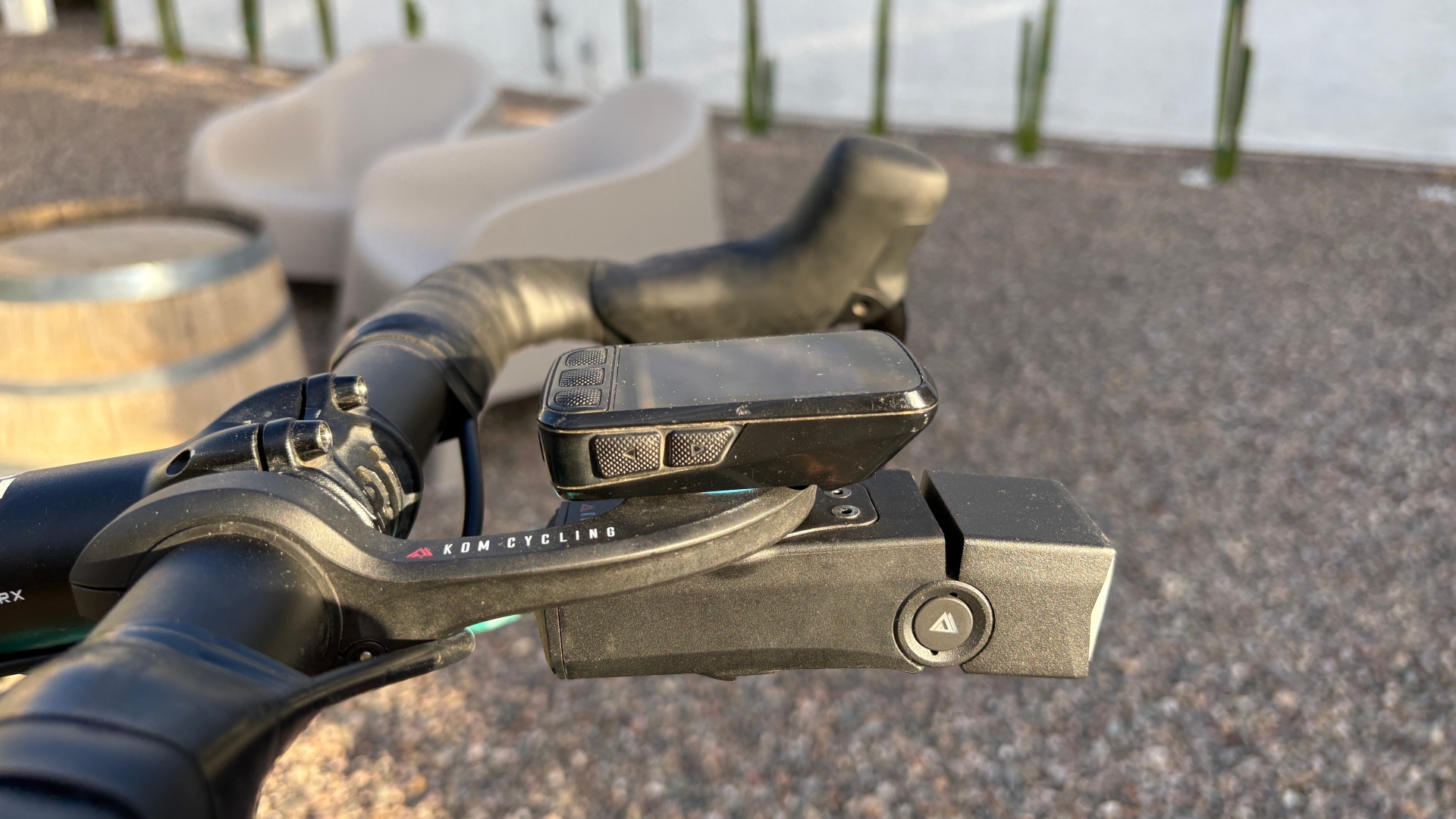
Mounting and orientation
How and where you mount a light on a bike can significantly affect not only how much you see but also how visible you are to other road users. This, of course, depends on where on your bike there is space to mount the lights. Traditionally, most are mounted on the handlebar or seatpost, but times are changing.
Most riders now use the best bike computers or smartphones, along with more aerodynamic or D-shaped seat posts, which take up valuable space on our handlebars and make mounting more complicated. We also need to consider other luggage and simple items like the best bike bells.
This is why considering how the manufacturer arranges the battery cells is very important and influences how you can mount the light. Longer, narrow units like those from Cateye or Knog work well on top of the handlebar but rarely perform as well underneath the bar, as they can obstruct cables and often do not have lenses in the correct orientation.
Lights such as those from Magicshine, Moon, and Lezyne, which can be mounted upside down thanks to clever lenses, tend to be shorter and slightly wider, making them more obtrusive but freeing up some space, especially if they can be mounted underneath a computer mount or on a fork leg.
What should I consider when choosing a rear light?
Though the amount of power you'll need for your front light will vary depending upon where you're riding, no cyclist should be without an adequate rear bike light. Rear bike lights will usually emit around 30 lumens or more, and generally have several modes: steady light, flashing, or a combination between the two. All options are safe and legal, but a flashing mode will usually help to save battery life and attract more attention.
Recently we have been introduced to the idea of using a rear bike light even in the daytime, because it will help drivers pick you out from behind. It's also a sensible idea to double up on rear lights. Though it's unlikely, you won't be quite so aware if your rear bike light fails as you would be in the case of a front beam, so having a back-up fitted can provide extra security and peace of mind.
For your rear light, the flash function is ideal. But if you’re a bike commuter, with both front and rear lights also consider how effective the lamp is in terms of side lighting, as this will make you more visible from more angles and help avoid the "sorry, I didn't see you" excuse from a turning vehicle.
It’s still generally a case of the brighter the better, but you also need to consider other qualities that will make your life easier. Look to see how many flash settings the light has; what the run times will be on a single charge or one set of batteries; and see if it has a rechargeable power source.
In this case, check if it needs its own special charger or if it can be recharged via USB, which aids convenience immensely. Some lights even have a helpful gauge showing how much power they have left.
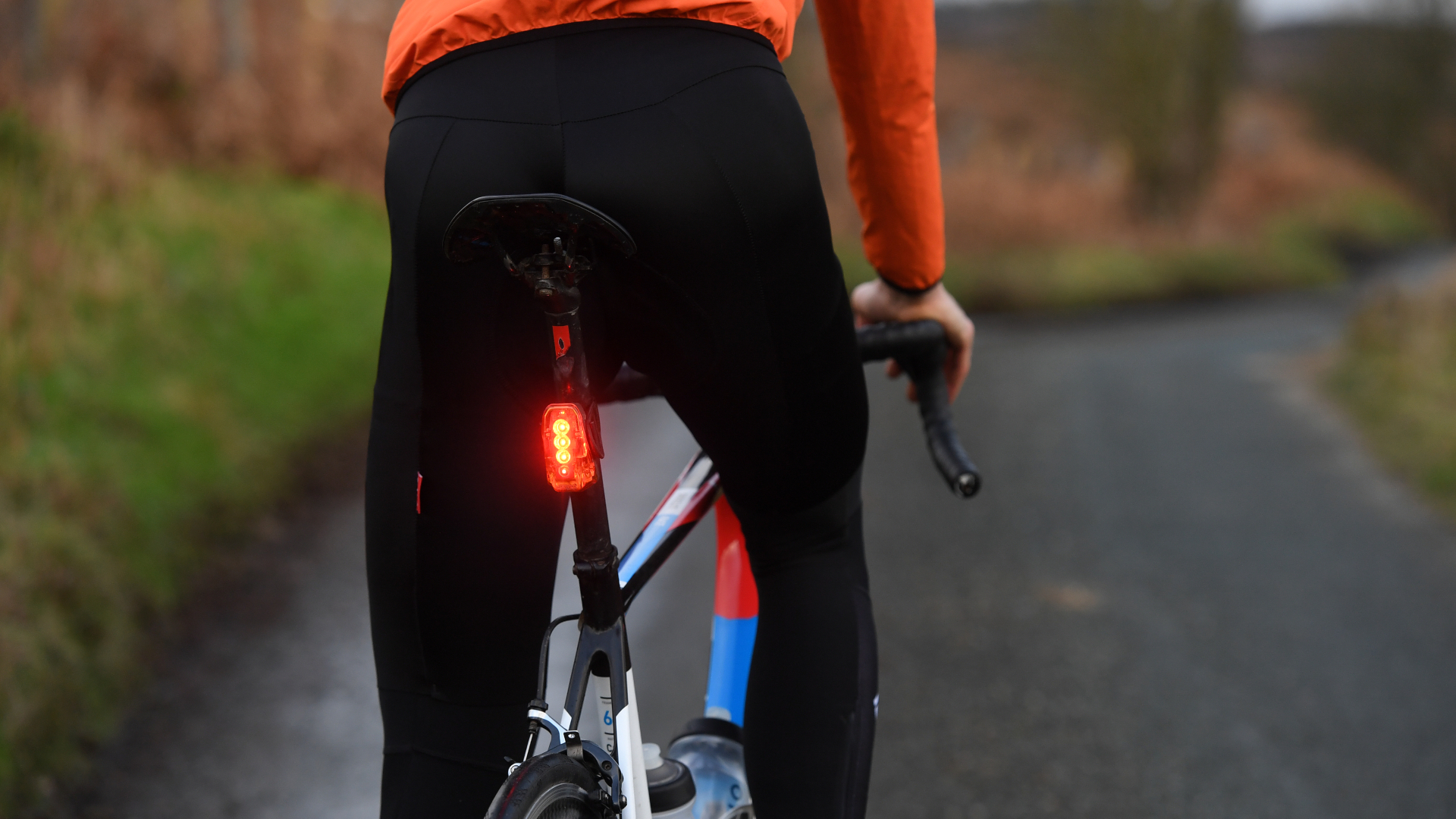
Frequently asked questions about bike lights
What do the battery life numbers mean?
For most lights above we've quoted a battery life range. All lights will have multiple modes, so the range is from the most intense to the most economical option.
Most lights will burn through the battery quickly in their highest mode. For fast riding on tricky off-road trails you might need this, but it's worth dialling down the light intensity if you're on easier terrain or tarmac. Your eyes will quickly acclimatise to the lower light level, while on their top output many bike lights can be as intense as a car headlight and dazzle oncoming traffic.
Some lights will dial down their intensity if they start to get too hot or as the battery begins to run down and so extend battery runtime.
Flashing modes give you the longest battery life. They're a good option to up your visibility, particularly at the rear and when riding in daylight, but unless there's good street lighting you'll probably want to run a constant mode at the front at night, which will reduce runtime. It's why front lights usually have larger capacity batteries than rear ones.
It's worth looking at the quotes runtimes in different modes when selecting a light.
What does UK law say about bike lights?
New bikes are sold with reflectors (and you can read in detail about the legal requirements relating to reflectors here) but regardless - if you're riding at night, using a proper set of bike lights is really an essential.
In the UK, law regarding bike lights is governed by the Road Vehicles Lighting Regulations, first published in 1989 but amended six times since, which say that as well as your pedal reflectors and rear reflectors (the side and front reflectors aren’t actually a legal necessity) night-riders will also need lights front and back.
The lights have to be mounted on the bike centrally or to the offside, positioned up to 1.5m from the ground, and conform to British Safety or EC standards.
Both front or rear lights can be flashers, but if so they must emit at least four candela. “But bike lights tend to be rated in lumens or Watts, what’s a candela?” we hear you cry.
It’s not a particularly easy subject to explain, and they’re not directly convertible units. But simply put: as long as you buy decent quality bike lights, fit them properly, and remember to switch them on, the law shouldn’t be a problem.
What does US law say about bike lights?
In the US, the law requires riders to have both active and passive lighting — active lighting is well...lights, while passive lighting is things like reflectors and reflective clothing.
The exact wording of the laws varies from state to state, but the summation of it all is that between sunset and sunrise or in conditions of 'limited visibility' you must have a white light pointing forwards, and a red light pointing backwards.
What is a stVZO-approved light?
Straßenverkehrs-Zulassungs-Ordnung, or stVZO for short, is the road traffic licensing regulation for German road users. These regulations include specific rulings on how bicycle lights must perform. This requirement is designed to prevent unnecessary glare or distractions to other road users when in use.
This is done by having strict specifications for the beam pattern. The beam patterns of stVZO lights will have a flat top and be focused towards the ground, slightly ahead of you on the road. Overall, the pattern looks a bit like an upside-down flat-topped pyramid. There are also regulations regarding the minimum output, colour, and warmth of lights.
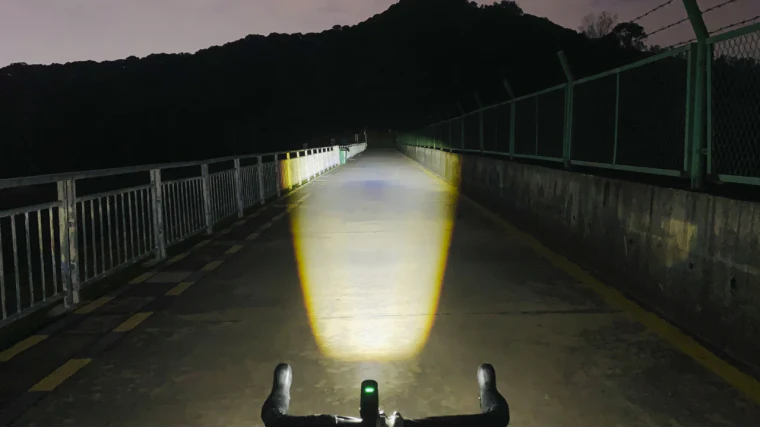
A depiction of the typical stVZO approved beam pattern
What is a smart or radar light?
Introduced over the last few years to bicycle lights, smart or radar lights include sensors that can spot cars and trucks approaching—generally from behind, but some also offer this feature for front lights. This is done in a couple of ways, using either light sensors or radar signals.
Once movement is detected, the light automatically adjusts its mode or setting to make you more visible. Depending on the manufacturer,, this is done in different ways, but generally, it is done by increasing the light's brightness or changing or adding a flashing pattern.
The standout performer in this market is the Garmin Varia, once linked with a Garmin computer, which visually represents how close and fast vehicles are approaching and adjusts the light to make you see.
What is the difference between Lux and Lumens?
Lux and Lumen, frequently confused, provide distinct metrics for assessing light performance. Lux quantifies the amount of light illuminating a surface, while Lumens assess the total light emitted in all directions from a source over a specific distance.
An effective bicycle light should achieve a proper balance between Lux and Lumens. Cyclists need the ability to illuminate specific objects such as vehicles, pedestrians, roadside furniture, or even trees and animals. Additionally, it's essential to have sufficient brightness to clearly see the surrounding area while riding.
Neither option holds greater significance, and lighting should not be chosen based solely on these criteria.
How should I mount my bike lights?
All bike lights will come with a mount to fit them to your bicycle, these will generally be placed around the handlebar and the seat post. It depends very much on the manufacturer, but sometimes this is a separate mount that needs to be fitted before mounting the light. For some, the mount is part of the light body and these typically are the more flexible ones that use a rubberised strap system.
The light should be positioned at handlebar height or approximately halfway up the seatpost. Numerous mounting options are available for attaching lights to fork legs, racks, and frames, all of which are valid placement locations.
Always position the light on the side of the bike closest to the traffic. For UK riders, this means placing it on the right side; for US or European riders, it should be on the left. Doing so provides drivers with a clearer reference for your width and theoretically grants you more space.
Do I need back-up bike lights or helmet-mounted bike lights for extra brightness?
A straightforward set of front and rear lights will often do the trick for the everyday bike commuter in urban environments. However, investing in the best lights you can afford is definitely a smart choice, and it’s a good idea to add an extra pair of inexpensive emergency flashers for extra safety. If you plan to venture off-road or ride on dark back roads, it’s essential to choose stronger, more powerful lamps with wider beams to keep you safe and seen.
Many riders also love to enhance their setup with helmet-mounted lights, which can be really effective! These lights can shine in the direction you’re looking, providing added visibility. However, remember that they should complement the lights on your bike and not replace them as your sole light source.
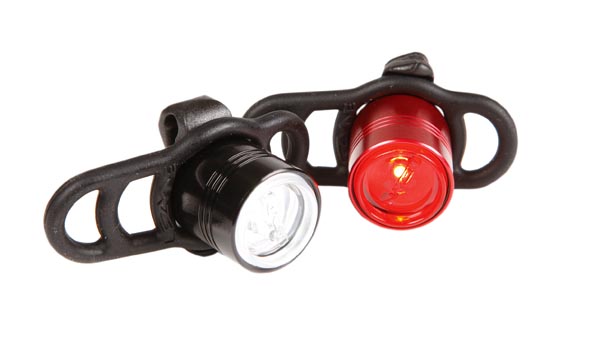
Are dynamo lights still a relevant option?
Dynamo lights are regaining popularity, especially among ultra-endurance and gravel racers. These racers choose them for their reliability and to minimize unnecessary charging stops.
Some dynamo light setups even allow you to charge other devices, such as top bicycle computers or phones. However, finding the right hub and light combination to meet your needs might require some trial and error, and installation can be somewhat tricky.
Are bike lights waterproof and what is an IPX waterproof rating?
IPX is the internationally recognised standard used to determine the amount of protection a device has against the ingress of typically water or dust. The standard also helps to understand whether something is just is 'weather-resistant' or 'waterproof.
The higher the IPX rating number, the greater the protection against ingress. The list below lays out what each IPX rating means and guides you on what level to look for in your next bicycle light.
• IPX-0 No protection
• IPX-1 Protected against condensation or water falling vertically
• IPX-2 Protected against spraying water when tilted up to 15 degrees vertically
• IPX-3 Protected against spraying water when tilted up to 60 degrees vertically
• IPX-4 Protected against splashing water from any angle
• IPX-5 Protected against low-pressure water stream from any angle
• IPX-6 Protected against high-pressure water stream from any angle
• IPX-7 Protected against water immersion for 30 minutes to a depth of one metre
• IPX-8 Protected against continual water submersion in underwater conditions
For good quality bicycle lights, we would expect to see a minimum of IPX-5. However ideally you should aim for IPX-6 as this will be a decent guarantee that water will not cause any issues with your device.
Should my bike lights flash?
Bicycle lights almost always include several modes where some kind of flashing pattern is emitted, be it with constant light or flashing on its own.
The legalities around flashing lights differ depending on where you live. For example, in Germany, flashing bike lights are not permitted at all. As mentioned above the stVZO guidance on bicycle lights is strict.
The research behind stVZO helps us understand what works well for riders' safety. Personally, I find front flashing lights very distracting, and the intensity of the cars' highlights doesn't change, so a constant front light is recommended.
There is much research on daytime running lights for rear lights, which tend to offer a very bright, slow, consistent flash. This suggests that, in theory, combining a constant bright light with a flash somewhat replicates a car's taillights when the brake is applied. Hopefully, this means cars see you first but also approach more cautiously.
If in doubt, place your lights on a constant mode in the brightest setting you have.
The latest race content, interviews, features, reviews and expert buying guides, direct to your inbox!
Like many, Matt began his bicycle industry journey on the spanners at his local bike shop. After spending his youth mountain biking, he was inspired to embrace gravel during his tenure with Evans Cycles' in-house brands, Pinnacle and Hoy Bikes. Recognising the evolving industry, Matt eagerly seized the chance to become an E-bike designer, winning several awards with the E-bike brand Cairn Cycles.
These days, Matt is likely to have a toddler sitting shotgun or off the beaten track somewhere on the South Downs.